Virtual Reality (VR) Assignment
VerifiedAdded on 2021/09/27
|28
|11643
|483
AI Summary
Contribute Materials
Your contribution can guide someone’s learning journey. Share your
documents today.
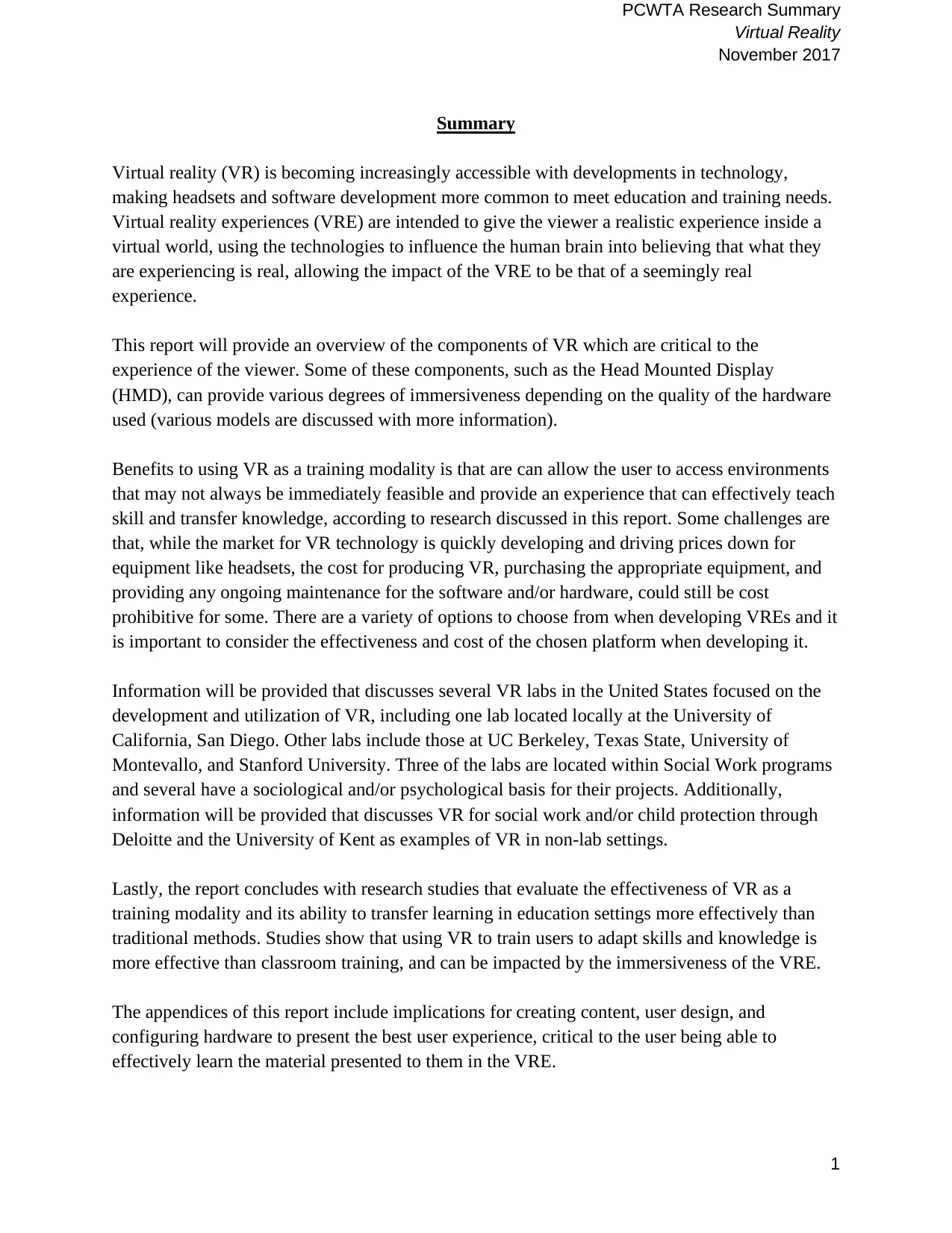
PCWTA Research Summary
Virtual Reality
November 2017
1
Summary
Virtual reality (VR) is becoming increasingly accessible with developments in technology,
making headsets and software development more common to meet education and training needs.
Virtual reality experiences (VRE) are intended to give the viewer a realistic experience inside a
virtual world, using the technologies to influence the human brain into believing that what they
are experiencing is real, allowing the impact of the VRE to be that of a seemingly real
experience.
This report will provide an overview of the components of VR which are critical to the
experience of the viewer. Some of these components, such as the Head Mounted Display
(HMD), can provide various degrees of immersiveness depending on the quality of the hardware
used (various models are discussed with more information).
Benefits to using VR as a training modality is that are can allow the user to access environments
that may not always be immediately feasible and provide an experience that can effectively teach
skill and transfer knowledge, according to research discussed in this report. Some challenges are
that, while the market for VR technology is quickly developing and driving prices down for
equipment like headsets, the cost for producing VR, purchasing the appropriate equipment, and
providing any ongoing maintenance for the software and/or hardware, could still be cost
prohibitive for some. There are a variety of options to choose from when developing VREs and it
is important to consider the effectiveness and cost of the chosen platform when developing it.
Information will be provided that discusses several VR labs in the United States focused on the
development and utilization of VR, including one lab located locally at the University of
California, San Diego. Other labs include those at UC Berkeley, Texas State, University of
Montevallo, and Stanford University. Three of the labs are located within Social Work programs
and several have a sociological and/or psychological basis for their projects. Additionally,
information will be provided that discusses VR for social work and/or child protection through
Deloitte and the University of Kent as examples of VR in non-lab settings.
Lastly, the report concludes with research studies that evaluate the effectiveness of VR as a
training modality and its ability to transfer learning in education settings more effectively than
traditional methods. Studies show that using VR to train users to adapt skills and knowledge is
more effective than classroom training, and can be impacted by the immersiveness of the VRE.
The appendices of this report include implications for creating content, user design, and
configuring hardware to present the best user experience, critical to the user being able to
effectively learn the material presented to them in the VRE.
Virtual Reality
November 2017
1
Summary
Virtual reality (VR) is becoming increasingly accessible with developments in technology,
making headsets and software development more common to meet education and training needs.
Virtual reality experiences (VRE) are intended to give the viewer a realistic experience inside a
virtual world, using the technologies to influence the human brain into believing that what they
are experiencing is real, allowing the impact of the VRE to be that of a seemingly real
experience.
This report will provide an overview of the components of VR which are critical to the
experience of the viewer. Some of these components, such as the Head Mounted Display
(HMD), can provide various degrees of immersiveness depending on the quality of the hardware
used (various models are discussed with more information).
Benefits to using VR as a training modality is that are can allow the user to access environments
that may not always be immediately feasible and provide an experience that can effectively teach
skill and transfer knowledge, according to research discussed in this report. Some challenges are
that, while the market for VR technology is quickly developing and driving prices down for
equipment like headsets, the cost for producing VR, purchasing the appropriate equipment, and
providing any ongoing maintenance for the software and/or hardware, could still be cost
prohibitive for some. There are a variety of options to choose from when developing VREs and it
is important to consider the effectiveness and cost of the chosen platform when developing it.
Information will be provided that discusses several VR labs in the United States focused on the
development and utilization of VR, including one lab located locally at the University of
California, San Diego. Other labs include those at UC Berkeley, Texas State, University of
Montevallo, and Stanford University. Three of the labs are located within Social Work programs
and several have a sociological and/or psychological basis for their projects. Additionally,
information will be provided that discusses VR for social work and/or child protection through
Deloitte and the University of Kent as examples of VR in non-lab settings.
Lastly, the report concludes with research studies that evaluate the effectiveness of VR as a
training modality and its ability to transfer learning in education settings more effectively than
traditional methods. Studies show that using VR to train users to adapt skills and knowledge is
more effective than classroom training, and can be impacted by the immersiveness of the VRE.
The appendices of this report include implications for creating content, user design, and
configuring hardware to present the best user experience, critical to the user being able to
effectively learn the material presented to them in the VRE.
Secure Best Marks with AI Grader
Need help grading? Try our AI Grader for instant feedback on your assignments.
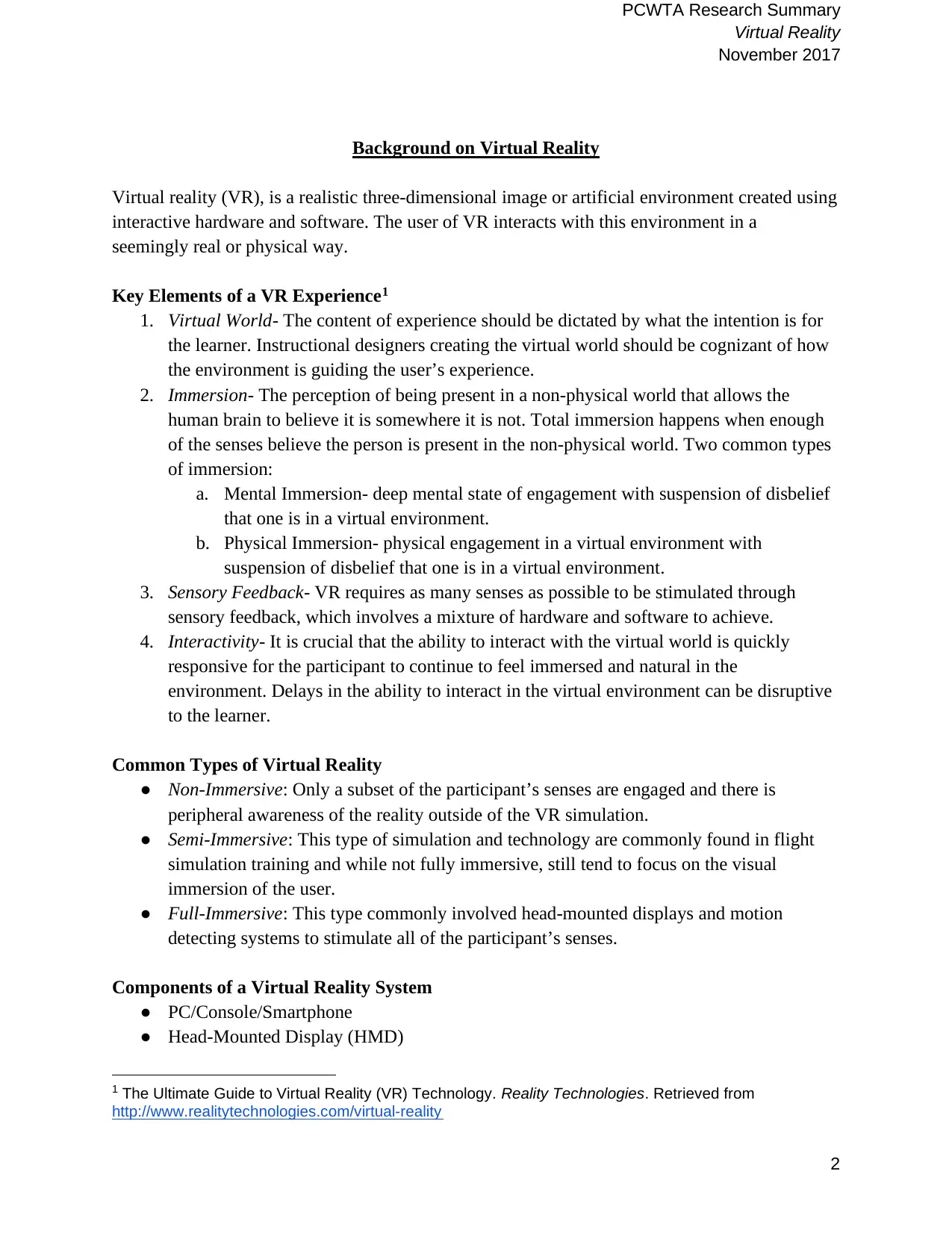
PCWTA Research Summary
Virtual Reality
November 2017
2
Background on Virtual Reality
Virtual reality (VR), is a realistic three-dimensional image or artificial environment created using
interactive hardware and software. The user of VR interacts with this environment in a
seemingly real or physical way.
Key Elements of a VR Experience1
1. Virtual World- The content of experience should be dictated by what the intention is for
the learner. Instructional designers creating the virtual world should be cognizant of how
the environment is guiding the user’s experience.
2. Immersion- The perception of being present in a non-physical world that allows the
human brain to believe it is somewhere it is not. Total immersion happens when enough
of the senses believe the person is present in the non-physical world. Two common types
of immersion:
a. Mental Immersion- deep mental state of engagement with suspension of disbelief
that one is in a virtual environment.
b. Physical Immersion- physical engagement in a virtual environment with
suspension of disbelief that one is in a virtual environment.
3. Sensory Feedback- VR requires as many senses as possible to be stimulated through
sensory feedback, which involves a mixture of hardware and software to achieve.
4. Interactivity- It is crucial that the ability to interact with the virtual world is quickly
responsive for the participant to continue to feel immersed and natural in the
environment. Delays in the ability to interact in the virtual environment can be disruptive
to the learner.
Common Types of Virtual Reality
● Non-Immersive: Only a subset of the participant’s senses are engaged and there is
peripheral awareness of the reality outside of the VR simulation.
● Semi-Immersive: This type of simulation and technology are commonly found in flight
simulation training and while not fully immersive, still tend to focus on the visual
immersion of the user.
● Full-Immersive: This type commonly involved head-mounted displays and motion
detecting systems to stimulate all of the participant’s senses.
Components of a Virtual Reality System
● PC/Console/Smartphone
● Head-Mounted Display (HMD)
1 The Ultimate Guide to Virtual Reality (VR) Technology. Reality Technologies. Retrieved from
http://www.realitytechnologies.com/virtual-reality
Virtual Reality
November 2017
2
Background on Virtual Reality
Virtual reality (VR), is a realistic three-dimensional image or artificial environment created using
interactive hardware and software. The user of VR interacts with this environment in a
seemingly real or physical way.
Key Elements of a VR Experience1
1. Virtual World- The content of experience should be dictated by what the intention is for
the learner. Instructional designers creating the virtual world should be cognizant of how
the environment is guiding the user’s experience.
2. Immersion- The perception of being present in a non-physical world that allows the
human brain to believe it is somewhere it is not. Total immersion happens when enough
of the senses believe the person is present in the non-physical world. Two common types
of immersion:
a. Mental Immersion- deep mental state of engagement with suspension of disbelief
that one is in a virtual environment.
b. Physical Immersion- physical engagement in a virtual environment with
suspension of disbelief that one is in a virtual environment.
3. Sensory Feedback- VR requires as many senses as possible to be stimulated through
sensory feedback, which involves a mixture of hardware and software to achieve.
4. Interactivity- It is crucial that the ability to interact with the virtual world is quickly
responsive for the participant to continue to feel immersed and natural in the
environment. Delays in the ability to interact in the virtual environment can be disruptive
to the learner.
Common Types of Virtual Reality
● Non-Immersive: Only a subset of the participant’s senses are engaged and there is
peripheral awareness of the reality outside of the VR simulation.
● Semi-Immersive: This type of simulation and technology are commonly found in flight
simulation training and while not fully immersive, still tend to focus on the visual
immersion of the user.
● Full-Immersive: This type commonly involved head-mounted displays and motion
detecting systems to stimulate all of the participant’s senses.
Components of a Virtual Reality System
● PC/Console/Smartphone
● Head-Mounted Display (HMD)
1 The Ultimate Guide to Virtual Reality (VR) Technology. Reality Technologies. Retrieved from
http://www.realitytechnologies.com/virtual-reality
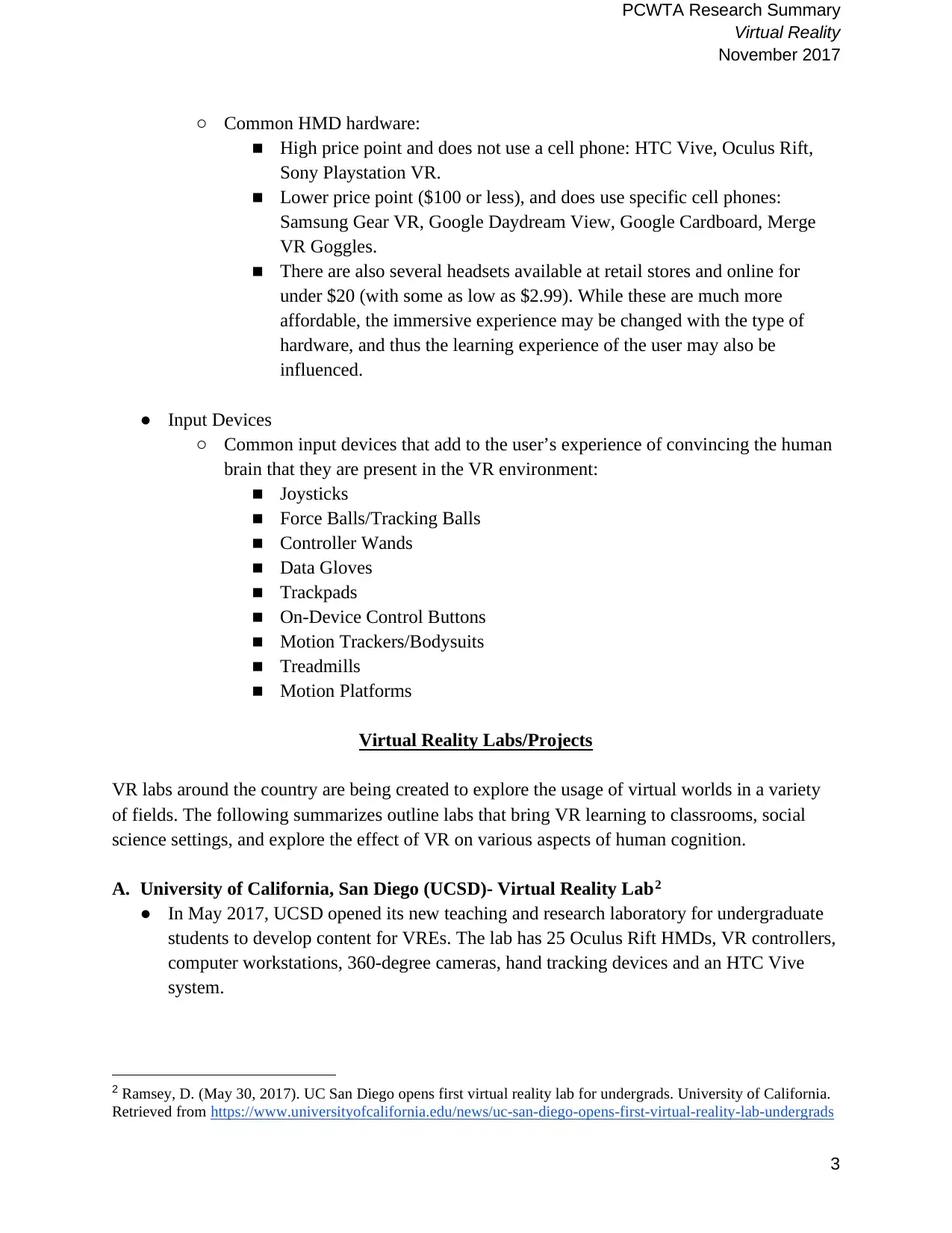
PCWTA Research Summary
Virtual Reality
November 2017
3
○ Common HMD hardware:
■ High price point and does not use a cell phone: HTC Vive, Oculus Rift,
Sony Playstation VR.
■ Lower price point ($100 or less), and does use specific cell phones:
Samsung Gear VR, Google Daydream View, Google Cardboard, Merge
VR Goggles.
■ There are also several headsets available at retail stores and online for
under $20 (with some as low as $2.99). While these are much more
affordable, the immersive experience may be changed with the type of
hardware, and thus the learning experience of the user may also be
influenced.
● Input Devices
○ Common input devices that add to the user’s experience of convincing the human
brain that they are present in the VR environment:
■ Joysticks
■ Force Balls/Tracking Balls
■ Controller Wands
■ Data Gloves
■ Trackpads
■ On-Device Control Buttons
■ Motion Trackers/Bodysuits
■ Treadmills
■ Motion Platforms
Virtual Reality Labs/Projects
VR labs around the country are being created to explore the usage of virtual worlds in a variety
of fields. The following summarizes outline labs that bring VR learning to classrooms, social
science settings, and explore the effect of VR on various aspects of human cognition.
A. University of California, San Diego (UCSD)- Virtual Reality Lab2
● In May 2017, UCSD opened its new teaching and research laboratory for undergraduate
students to develop content for VREs. The lab has 25 Oculus Rift HMDs, VR controllers,
computer workstations, 360-degree cameras, hand tracking devices and an HTC Vive
system.
2 Ramsey, D. (May 30, 2017). UC San Diego opens first virtual reality lab for undergrads. University of California.
Retrieved from https://www.universityofcalifornia.edu/news/uc-san-diego-opens-first-virtual-reality-lab-undergrads
Virtual Reality
November 2017
3
○ Common HMD hardware:
■ High price point and does not use a cell phone: HTC Vive, Oculus Rift,
Sony Playstation VR.
■ Lower price point ($100 or less), and does use specific cell phones:
Samsung Gear VR, Google Daydream View, Google Cardboard, Merge
VR Goggles.
■ There are also several headsets available at retail stores and online for
under $20 (with some as low as $2.99). While these are much more
affordable, the immersive experience may be changed with the type of
hardware, and thus the learning experience of the user may also be
influenced.
● Input Devices
○ Common input devices that add to the user’s experience of convincing the human
brain that they are present in the VR environment:
■ Joysticks
■ Force Balls/Tracking Balls
■ Controller Wands
■ Data Gloves
■ Trackpads
■ On-Device Control Buttons
■ Motion Trackers/Bodysuits
■ Treadmills
■ Motion Platforms
Virtual Reality Labs/Projects
VR labs around the country are being created to explore the usage of virtual worlds in a variety
of fields. The following summarizes outline labs that bring VR learning to classrooms, social
science settings, and explore the effect of VR on various aspects of human cognition.
A. University of California, San Diego (UCSD)- Virtual Reality Lab2
● In May 2017, UCSD opened its new teaching and research laboratory for undergraduate
students to develop content for VREs. The lab has 25 Oculus Rift HMDs, VR controllers,
computer workstations, 360-degree cameras, hand tracking devices and an HTC Vive
system.
2 Ramsey, D. (May 30, 2017). UC San Diego opens first virtual reality lab for undergrads. University of California.
Retrieved from https://www.universityofcalifornia.edu/news/uc-san-diego-opens-first-virtual-reality-lab-undergrads
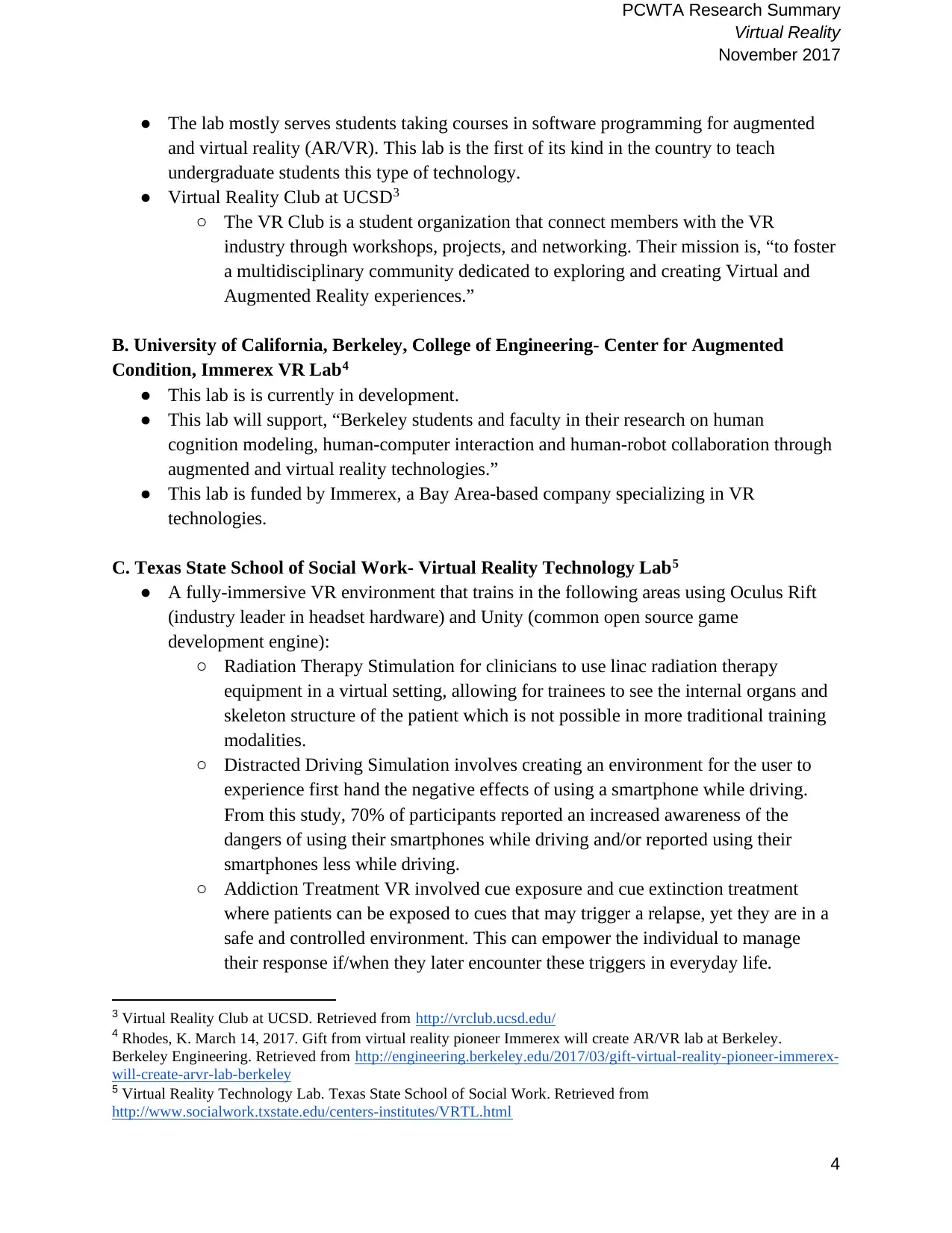
PCWTA Research Summary
Virtual Reality
November 2017
4
● The lab mostly serves students taking courses in software programming for augmented
and virtual reality (AR/VR). This lab is the first of its kind in the country to teach
undergraduate students this type of technology.
● Virtual Reality Club at UCSD3
○ The VR Club is a student organization that connect members with the VR
industry through workshops, projects, and networking. Their mission is, “to foster
a multidisciplinary community dedicated to exploring and creating Virtual and
Augmented Reality experiences.”
B. University of California, Berkeley, College of Engineering- Center for Augmented
Condition, Immerex VR Lab4
● This lab is is currently in development.
● This lab will support, “Berkeley students and faculty in their research on human
cognition modeling, human-computer interaction and human-robot collaboration through
augmented and virtual reality technologies.”
● This lab is funded by Immerex, a Bay Area-based company specializing in VR
technologies.
C. Texas State School of Social Work- Virtual Reality Technology Lab5
● A fully-immersive VR environment that trains in the following areas using Oculus Rift
(industry leader in headset hardware) and Unity (common open source game
development engine):
○ Radiation Therapy Stimulation for clinicians to use linac radiation therapy
equipment in a virtual setting, allowing for trainees to see the internal organs and
skeleton structure of the patient which is not possible in more traditional training
modalities.
○ Distracted Driving Simulation involves creating an environment for the user to
experience first hand the negative effects of using a smartphone while driving.
From this study, 70% of participants reported an increased awareness of the
dangers of using their smartphones while driving and/or reported using their
smartphones less while driving.
○ Addiction Treatment VR involved cue exposure and cue extinction treatment
where patients can be exposed to cues that may trigger a relapse, yet they are in a
safe and controlled environment. This can empower the individual to manage
their response if/when they later encounter these triggers in everyday life.
3 Virtual Reality Club at UCSD. Retrieved from http://vrclub.ucsd.edu/
4 Rhodes, K. March 14, 2017. Gift from virtual reality pioneer Immerex will create AR/VR lab at Berkeley.
Berkeley Engineering. Retrieved from http://engineering.berkeley.edu/2017/03/gift-virtual-reality-pioneer-immerex-
will-create-arvr-lab-berkeley
5 Virtual Reality Technology Lab. Texas State School of Social Work. Retrieved from
http://www.socialwork.txstate.edu/centers-institutes/VRTL.html
Virtual Reality
November 2017
4
● The lab mostly serves students taking courses in software programming for augmented
and virtual reality (AR/VR). This lab is the first of its kind in the country to teach
undergraduate students this type of technology.
● Virtual Reality Club at UCSD3
○ The VR Club is a student organization that connect members with the VR
industry through workshops, projects, and networking. Their mission is, “to foster
a multidisciplinary community dedicated to exploring and creating Virtual and
Augmented Reality experiences.”
B. University of California, Berkeley, College of Engineering- Center for Augmented
Condition, Immerex VR Lab4
● This lab is is currently in development.
● This lab will support, “Berkeley students and faculty in their research on human
cognition modeling, human-computer interaction and human-robot collaboration through
augmented and virtual reality technologies.”
● This lab is funded by Immerex, a Bay Area-based company specializing in VR
technologies.
C. Texas State School of Social Work- Virtual Reality Technology Lab5
● A fully-immersive VR environment that trains in the following areas using Oculus Rift
(industry leader in headset hardware) and Unity (common open source game
development engine):
○ Radiation Therapy Stimulation for clinicians to use linac radiation therapy
equipment in a virtual setting, allowing for trainees to see the internal organs and
skeleton structure of the patient which is not possible in more traditional training
modalities.
○ Distracted Driving Simulation involves creating an environment for the user to
experience first hand the negative effects of using a smartphone while driving.
From this study, 70% of participants reported an increased awareness of the
dangers of using their smartphones while driving and/or reported using their
smartphones less while driving.
○ Addiction Treatment VR involved cue exposure and cue extinction treatment
where patients can be exposed to cues that may trigger a relapse, yet they are in a
safe and controlled environment. This can empower the individual to manage
their response if/when they later encounter these triggers in everyday life.
3 Virtual Reality Club at UCSD. Retrieved from http://vrclub.ucsd.edu/
4 Rhodes, K. March 14, 2017. Gift from virtual reality pioneer Immerex will create AR/VR lab at Berkeley.
Berkeley Engineering. Retrieved from http://engineering.berkeley.edu/2017/03/gift-virtual-reality-pioneer-immerex-
will-create-arvr-lab-berkeley
5 Virtual Reality Technology Lab. Texas State School of Social Work. Retrieved from
http://www.socialwork.txstate.edu/centers-institutes/VRTL.html
Secure Best Marks with AI Grader
Need help grading? Try our AI Grader for instant feedback on your assignments.
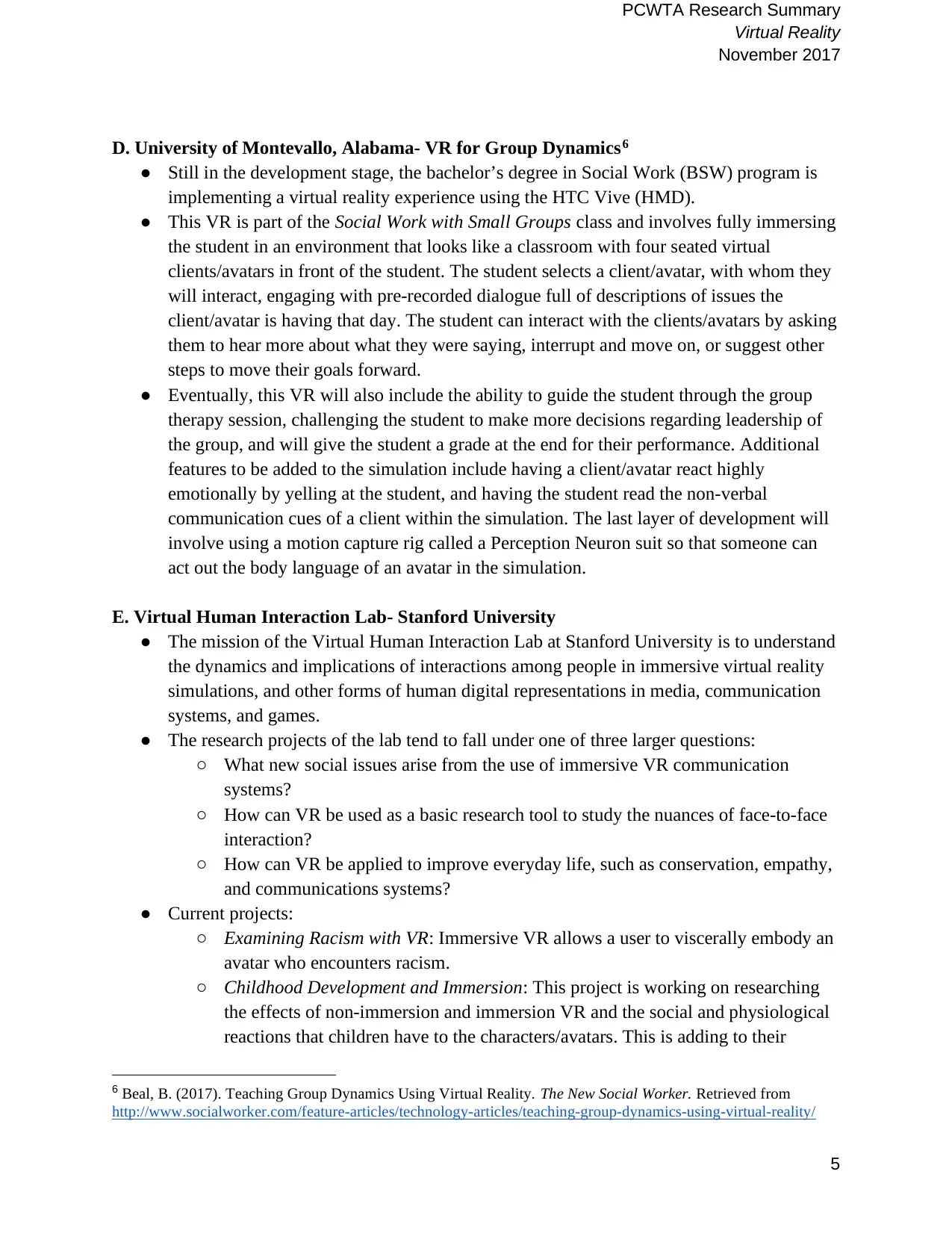
PCWTA Research Summary
Virtual Reality
November 2017
5
D. University of Montevallo, Alabama- VR for Group Dynamics6
● Still in the development stage, the bachelor’s degree in Social Work (BSW) program is
implementing a virtual reality experience using the HTC Vive (HMD).
● This VR is part of the Social Work with Small Groups class and involves fully immersing
the student in an environment that looks like a classroom with four seated virtual
clients/avatars in front of the student. The student selects a client/avatar, with whom they
will interact, engaging with pre-recorded dialogue full of descriptions of issues the
client/avatar is having that day. The student can interact with the clients/avatars by asking
them to hear more about what they were saying, interrupt and move on, or suggest other
steps to move their goals forward.
● Eventually, this VR will also include the ability to guide the student through the group
therapy session, challenging the student to make more decisions regarding leadership of
the group, and will give the student a grade at the end for their performance. Additional
features to be added to the simulation include having a client/avatar react highly
emotionally by yelling at the student, and having the student read the non-verbal
communication cues of a client within the simulation. The last layer of development will
involve using a motion capture rig called a Perception Neuron suit so that someone can
act out the body language of an avatar in the simulation.
E. Virtual Human Interaction Lab- Stanford University
● The mission of the Virtual Human Interaction Lab at Stanford University is to understand
the dynamics and implications of interactions among people in immersive virtual reality
simulations, and other forms of human digital representations in media, communication
systems, and games.
● The research projects of the lab tend to fall under one of three larger questions:
○ What new social issues arise from the use of immersive VR communication
systems?
○ How can VR be used as a basic research tool to study the nuances of face-to-face
interaction?
○ How can VR be applied to improve everyday life, such as conservation, empathy,
and communications systems?
● Current projects:
○ Examining Racism with VR: Immersive VR allows a user to viscerally embody an
avatar who encounters racism.
○ Childhood Development and Immersion: This project is working on researching
the effects of non-immersion and immersion VR and the social and physiological
reactions that children have to the characters/avatars. This is adding to their
6 Beal, B. (2017). Teaching Group Dynamics Using Virtual Reality. The New Social Worker. Retrieved from
http://www.socialworker.com/feature-articles/technology-articles/teaching-group-dynamics-using-virtual-reality/
Virtual Reality
November 2017
5
D. University of Montevallo, Alabama- VR for Group Dynamics6
● Still in the development stage, the bachelor’s degree in Social Work (BSW) program is
implementing a virtual reality experience using the HTC Vive (HMD).
● This VR is part of the Social Work with Small Groups class and involves fully immersing
the student in an environment that looks like a classroom with four seated virtual
clients/avatars in front of the student. The student selects a client/avatar, with whom they
will interact, engaging with pre-recorded dialogue full of descriptions of issues the
client/avatar is having that day. The student can interact with the clients/avatars by asking
them to hear more about what they were saying, interrupt and move on, or suggest other
steps to move their goals forward.
● Eventually, this VR will also include the ability to guide the student through the group
therapy session, challenging the student to make more decisions regarding leadership of
the group, and will give the student a grade at the end for their performance. Additional
features to be added to the simulation include having a client/avatar react highly
emotionally by yelling at the student, and having the student read the non-verbal
communication cues of a client within the simulation. The last layer of development will
involve using a motion capture rig called a Perception Neuron suit so that someone can
act out the body language of an avatar in the simulation.
E. Virtual Human Interaction Lab- Stanford University
● The mission of the Virtual Human Interaction Lab at Stanford University is to understand
the dynamics and implications of interactions among people in immersive virtual reality
simulations, and other forms of human digital representations in media, communication
systems, and games.
● The research projects of the lab tend to fall under one of three larger questions:
○ What new social issues arise from the use of immersive VR communication
systems?
○ How can VR be used as a basic research tool to study the nuances of face-to-face
interaction?
○ How can VR be applied to improve everyday life, such as conservation, empathy,
and communications systems?
● Current projects:
○ Examining Racism with VR: Immersive VR allows a user to viscerally embody an
avatar who encounters racism.
○ Childhood Development and Immersion: This project is working on researching
the effects of non-immersion and immersion VR and the social and physiological
reactions that children have to the characters/avatars. This is adding to their
6 Beal, B. (2017). Teaching Group Dynamics Using Virtual Reality. The New Social Worker. Retrieved from
http://www.socialworker.com/feature-articles/technology-articles/teaching-group-dynamics-using-virtual-reality/
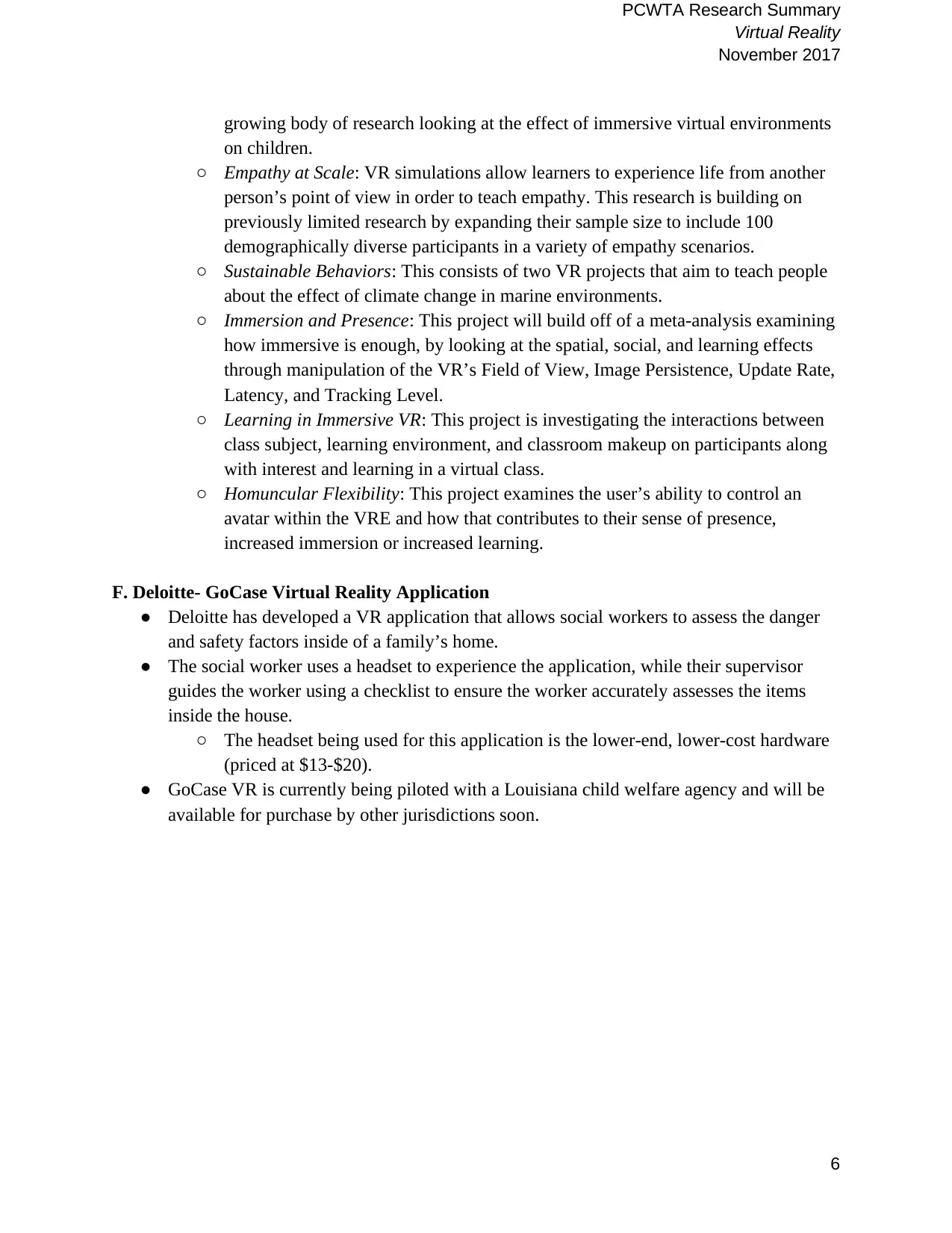
PCWTA Research Summary
Virtual Reality
November 2017
6
growing body of research looking at the effect of immersive virtual environments
on children.
○ Empathy at Scale: VR simulations allow learners to experience life from another
person’s point of view in order to teach empathy. This research is building on
previously limited research by expanding their sample size to include 100
demographically diverse participants in a variety of empathy scenarios.
○ Sustainable Behaviors: This consists of two VR projects that aim to teach people
about the effect of climate change in marine environments.
○ Immersion and Presence: This project will build off of a meta-analysis examining
how immersive is enough, by looking at the spatial, social, and learning effects
through manipulation of the VR’s Field of View, Image Persistence, Update Rate,
Latency, and Tracking Level.
○ Learning in Immersive VR: This project is investigating the interactions between
class subject, learning environment, and classroom makeup on participants along
with interest and learning in a virtual class.
○ Homuncular Flexibility: This project examines the user’s ability to control an
avatar within the VRE and how that contributes to their sense of presence,
increased immersion or increased learning.
F. Deloitte- GoCase Virtual Reality Application
● Deloitte has developed a VR application that allows social workers to assess the danger
and safety factors inside of a family’s home.
● The social worker uses a headset to experience the application, while their supervisor
guides the worker using a checklist to ensure the worker accurately assesses the items
inside the house.
○ The headset being used for this application is the lower-end, lower-cost hardware
(priced at $13-$20).
● GoCase VR is currently being piloted with a Louisiana child welfare agency and will be
available for purchase by other jurisdictions soon.
Virtual Reality
November 2017
6
growing body of research looking at the effect of immersive virtual environments
on children.
○ Empathy at Scale: VR simulations allow learners to experience life from another
person’s point of view in order to teach empathy. This research is building on
previously limited research by expanding their sample size to include 100
demographically diverse participants in a variety of empathy scenarios.
○ Sustainable Behaviors: This consists of two VR projects that aim to teach people
about the effect of climate change in marine environments.
○ Immersion and Presence: This project will build off of a meta-analysis examining
how immersive is enough, by looking at the spatial, social, and learning effects
through manipulation of the VR’s Field of View, Image Persistence, Update Rate,
Latency, and Tracking Level.
○ Learning in Immersive VR: This project is investigating the interactions between
class subject, learning environment, and classroom makeup on participants along
with interest and learning in a virtual class.
○ Homuncular Flexibility: This project examines the user’s ability to control an
avatar within the VRE and how that contributes to their sense of presence,
increased immersion or increased learning.
F. Deloitte- GoCase Virtual Reality Application
● Deloitte has developed a VR application that allows social workers to assess the danger
and safety factors inside of a family’s home.
● The social worker uses a headset to experience the application, while their supervisor
guides the worker using a checklist to ensure the worker accurately assesses the items
inside the house.
○ The headset being used for this application is the lower-end, lower-cost hardware
(priced at $13-$20).
● GoCase VR is currently being piloted with a Louisiana child welfare agency and will be
available for purchase by other jurisdictions soon.
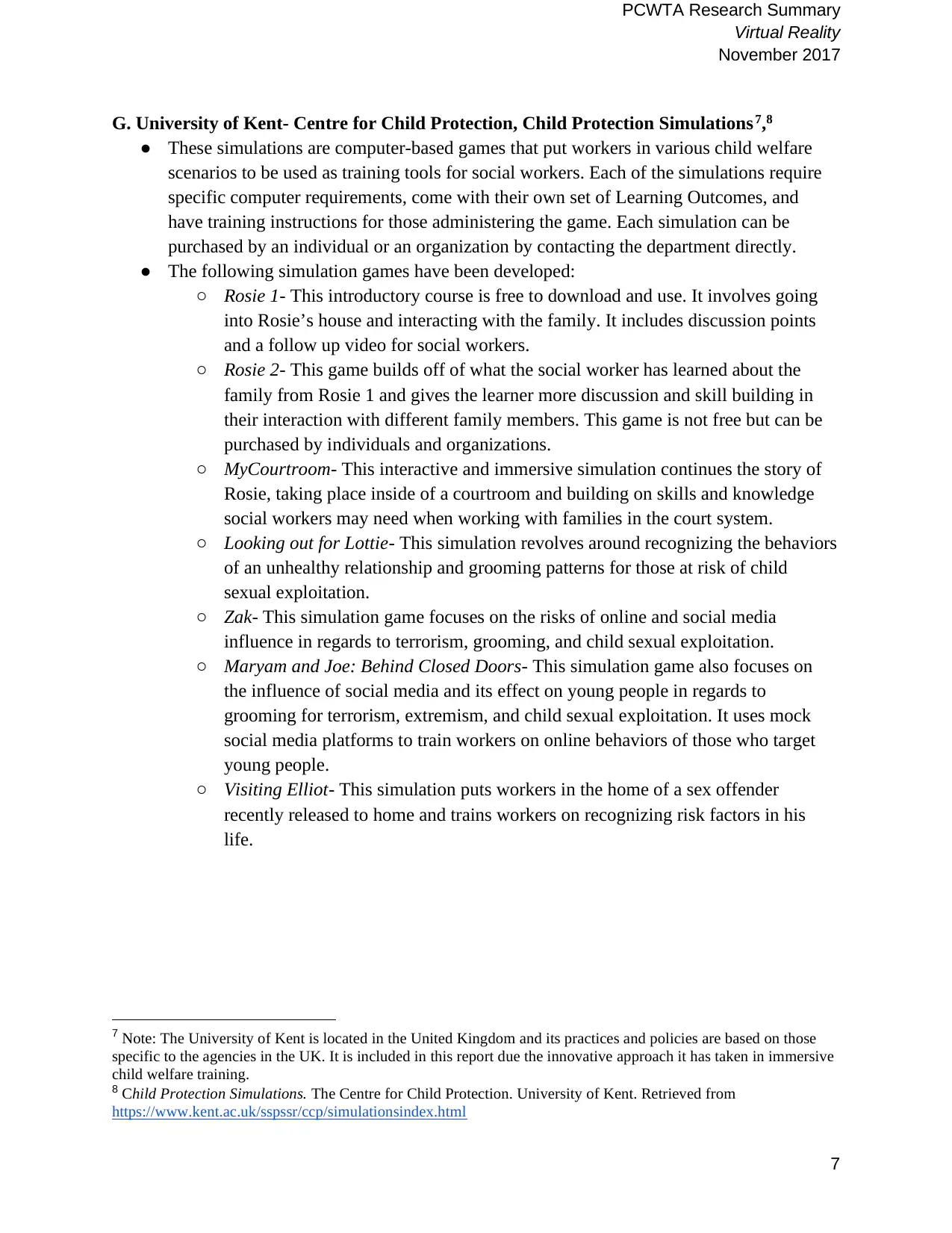
PCWTA Research Summary
Virtual Reality
November 2017
7
G. University of Kent- Centre for Child Protection, Child Protection Simulations7,8
● These simulations are computer-based games that put workers in various child welfare
scenarios to be used as training tools for social workers. Each of the simulations require
specific computer requirements, come with their own set of Learning Outcomes, and
have training instructions for those administering the game. Each simulation can be
purchased by an individual or an organization by contacting the department directly.
● The following simulation games have been developed:
○ Rosie 1- This introductory course is free to download and use. It involves going
into Rosie’s house and interacting with the family. It includes discussion points
and a follow up video for social workers.
○ Rosie 2- This game builds off of what the social worker has learned about the
family from Rosie 1 and gives the learner more discussion and skill building in
their interaction with different family members. This game is not free but can be
purchased by individuals and organizations.
○ MyCourtroom- This interactive and immersive simulation continues the story of
Rosie, taking place inside of a courtroom and building on skills and knowledge
social workers may need when working with families in the court system.
○ Looking out for Lottie- This simulation revolves around recognizing the behaviors
of an unhealthy relationship and grooming patterns for those at risk of child
sexual exploitation.
○ Zak- This simulation game focuses on the risks of online and social media
influence in regards to terrorism, grooming, and child sexual exploitation.
○ Maryam and Joe: Behind Closed Doors- This simulation game also focuses on
the influence of social media and its effect on young people in regards to
grooming for terrorism, extremism, and child sexual exploitation. It uses mock
social media platforms to train workers on online behaviors of those who target
young people.
○ Visiting Elliot- This simulation puts workers in the home of a sex offender
recently released to home and trains workers on recognizing risk factors in his
life.
7 Note: The University of Kent is located in the United Kingdom and its practices and policies are based on those
specific to the agencies in the UK. It is included in this report due the innovative approach it has taken in immersive
child welfare training.
8 Child Protection Simulations. The Centre for Child Protection. University of Kent. Retrieved from
https://www.kent.ac.uk/sspssr/ccp/simulationsindex.html
Virtual Reality
November 2017
7
G. University of Kent- Centre for Child Protection, Child Protection Simulations7,8
● These simulations are computer-based games that put workers in various child welfare
scenarios to be used as training tools for social workers. Each of the simulations require
specific computer requirements, come with their own set of Learning Outcomes, and
have training instructions for those administering the game. Each simulation can be
purchased by an individual or an organization by contacting the department directly.
● The following simulation games have been developed:
○ Rosie 1- This introductory course is free to download and use. It involves going
into Rosie’s house and interacting with the family. It includes discussion points
and a follow up video for social workers.
○ Rosie 2- This game builds off of what the social worker has learned about the
family from Rosie 1 and gives the learner more discussion and skill building in
their interaction with different family members. This game is not free but can be
purchased by individuals and organizations.
○ MyCourtroom- This interactive and immersive simulation continues the story of
Rosie, taking place inside of a courtroom and building on skills and knowledge
social workers may need when working with families in the court system.
○ Looking out for Lottie- This simulation revolves around recognizing the behaviors
of an unhealthy relationship and grooming patterns for those at risk of child
sexual exploitation.
○ Zak- This simulation game focuses on the risks of online and social media
influence in regards to terrorism, grooming, and child sexual exploitation.
○ Maryam and Joe: Behind Closed Doors- This simulation game also focuses on
the influence of social media and its effect on young people in regards to
grooming for terrorism, extremism, and child sexual exploitation. It uses mock
social media platforms to train workers on online behaviors of those who target
young people.
○ Visiting Elliot- This simulation puts workers in the home of a sex offender
recently released to home and trains workers on recognizing risk factors in his
life.
7 Note: The University of Kent is located in the United Kingdom and its practices and policies are based on those
specific to the agencies in the UK. It is included in this report due the innovative approach it has taken in immersive
child welfare training.
8 Child Protection Simulations. The Centre for Child Protection. University of Kent. Retrieved from
https://www.kent.ac.uk/sspssr/ccp/simulationsindex.html
Paraphrase This Document
Need a fresh take? Get an instant paraphrase of this document with our AI Paraphraser
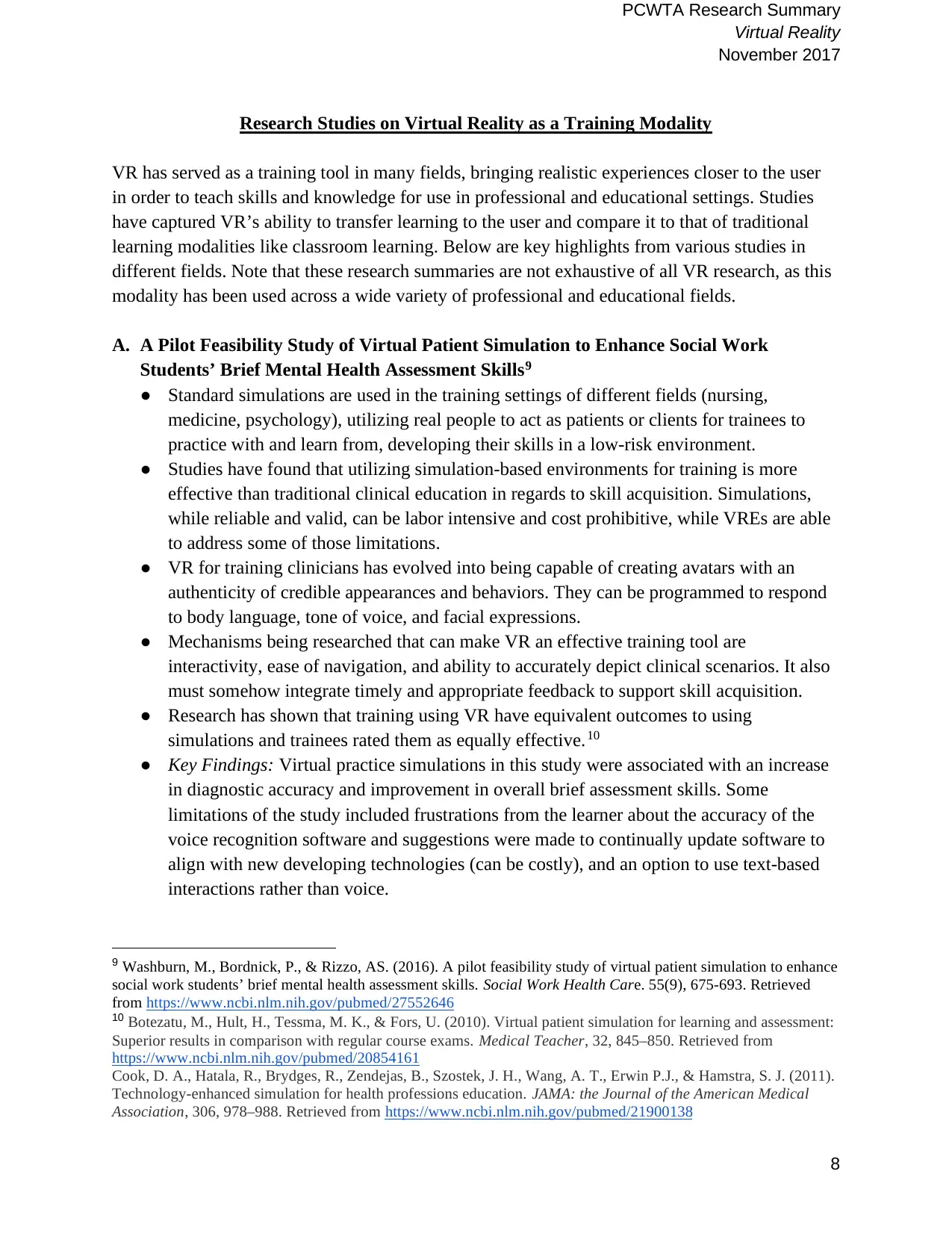
PCWTA Research Summary
Virtual Reality
November 2017
8
Research Studies on Virtual Reality as a Training Modality
VR has served as a training tool in many fields, bringing realistic experiences closer to the user
in order to teach skills and knowledge for use in professional and educational settings. Studies
have captured VR’s ability to transfer learning to the user and compare it to that of traditional
learning modalities like classroom learning. Below are key highlights from various studies in
different fields. Note that these research summaries are not exhaustive of all VR research, as this
modality has been used across a wide variety of professional and educational fields.
A. A Pilot Feasibility Study of Virtual Patient Simulation to Enhance Social Work
Students’ Brief Mental Health Assessment Skills9
● Standard simulations are used in the training settings of different fields (nursing,
medicine, psychology), utilizing real people to act as patients or clients for trainees to
practice with and learn from, developing their skills in a low-risk environment.
● Studies have found that utilizing simulation-based environments for training is more
effective than traditional clinical education in regards to skill acquisition. Simulations,
while reliable and valid, can be labor intensive and cost prohibitive, while VREs are able
to address some of those limitations.
● VR for training clinicians has evolved into being capable of creating avatars with an
authenticity of credible appearances and behaviors. They can be programmed to respond
to body language, tone of voice, and facial expressions.
● Mechanisms being researched that can make VR an effective training tool are
interactivity, ease of navigation, and ability to accurately depict clinical scenarios. It also
must somehow integrate timely and appropriate feedback to support skill acquisition.
● Research has shown that training using VR have equivalent outcomes to using
simulations and trainees rated them as equally effective.10
● Key Findings: Virtual practice simulations in this study were associated with an increase
in diagnostic accuracy and improvement in overall brief assessment skills. Some
limitations of the study included frustrations from the learner about the accuracy of the
voice recognition software and suggestions were made to continually update software to
align with new developing technologies (can be costly), and an option to use text-based
interactions rather than voice.
9 Washburn, M., Bordnick, P., & Rizzo, AS. (2016). A pilot feasibility study of virtual patient simulation to enhance
social work students’ brief mental health assessment skills. Social Work Health Care. 55(9), 675-693. Retrieved
from https://www.ncbi.nlm.nih.gov/pubmed/27552646
10 Botezatu, M., Hult, H., Tessma, M. K., & Fors, U. (2010). Virtual patient simulation for learning and assessment:
Superior results in comparison with regular course exams. Medical Teacher, 32, 845–850. Retrieved from
https://www.ncbi.nlm.nih.gov/pubmed/20854161
Cook, D. A., Hatala, R., Brydges, R., Zendejas, B., Szostek, J. H., Wang, A. T., Erwin P.J., & Hamstra, S. J. (2011).
Technology-enhanced simulation for health professions education. JAMA: the Journal of the American Medical
Association, 306, 978–988. Retrieved from https://www.ncbi.nlm.nih.gov/pubmed/21900138
Virtual Reality
November 2017
8
Research Studies on Virtual Reality as a Training Modality
VR has served as a training tool in many fields, bringing realistic experiences closer to the user
in order to teach skills and knowledge for use in professional and educational settings. Studies
have captured VR’s ability to transfer learning to the user and compare it to that of traditional
learning modalities like classroom learning. Below are key highlights from various studies in
different fields. Note that these research summaries are not exhaustive of all VR research, as this
modality has been used across a wide variety of professional and educational fields.
A. A Pilot Feasibility Study of Virtual Patient Simulation to Enhance Social Work
Students’ Brief Mental Health Assessment Skills9
● Standard simulations are used in the training settings of different fields (nursing,
medicine, psychology), utilizing real people to act as patients or clients for trainees to
practice with and learn from, developing their skills in a low-risk environment.
● Studies have found that utilizing simulation-based environments for training is more
effective than traditional clinical education in regards to skill acquisition. Simulations,
while reliable and valid, can be labor intensive and cost prohibitive, while VREs are able
to address some of those limitations.
● VR for training clinicians has evolved into being capable of creating avatars with an
authenticity of credible appearances and behaviors. They can be programmed to respond
to body language, tone of voice, and facial expressions.
● Mechanisms being researched that can make VR an effective training tool are
interactivity, ease of navigation, and ability to accurately depict clinical scenarios. It also
must somehow integrate timely and appropriate feedback to support skill acquisition.
● Research has shown that training using VR have equivalent outcomes to using
simulations and trainees rated them as equally effective.10
● Key Findings: Virtual practice simulations in this study were associated with an increase
in diagnostic accuracy and improvement in overall brief assessment skills. Some
limitations of the study included frustrations from the learner about the accuracy of the
voice recognition software and suggestions were made to continually update software to
align with new developing technologies (can be costly), and an option to use text-based
interactions rather than voice.
9 Washburn, M., Bordnick, P., & Rizzo, AS. (2016). A pilot feasibility study of virtual patient simulation to enhance
social work students’ brief mental health assessment skills. Social Work Health Care. 55(9), 675-693. Retrieved
from https://www.ncbi.nlm.nih.gov/pubmed/27552646
10 Botezatu, M., Hult, H., Tessma, M. K., & Fors, U. (2010). Virtual patient simulation for learning and assessment:
Superior results in comparison with regular course exams. Medical Teacher, 32, 845–850. Retrieved from
https://www.ncbi.nlm.nih.gov/pubmed/20854161
Cook, D. A., Hatala, R., Brydges, R., Zendejas, B., Szostek, J. H., Wang, A. T., Erwin P.J., & Hamstra, S. J. (2011).
Technology-enhanced simulation for health professions education. JAMA: the Journal of the American Medical
Association, 306, 978–988. Retrieved from https://www.ncbi.nlm.nih.gov/pubmed/21900138
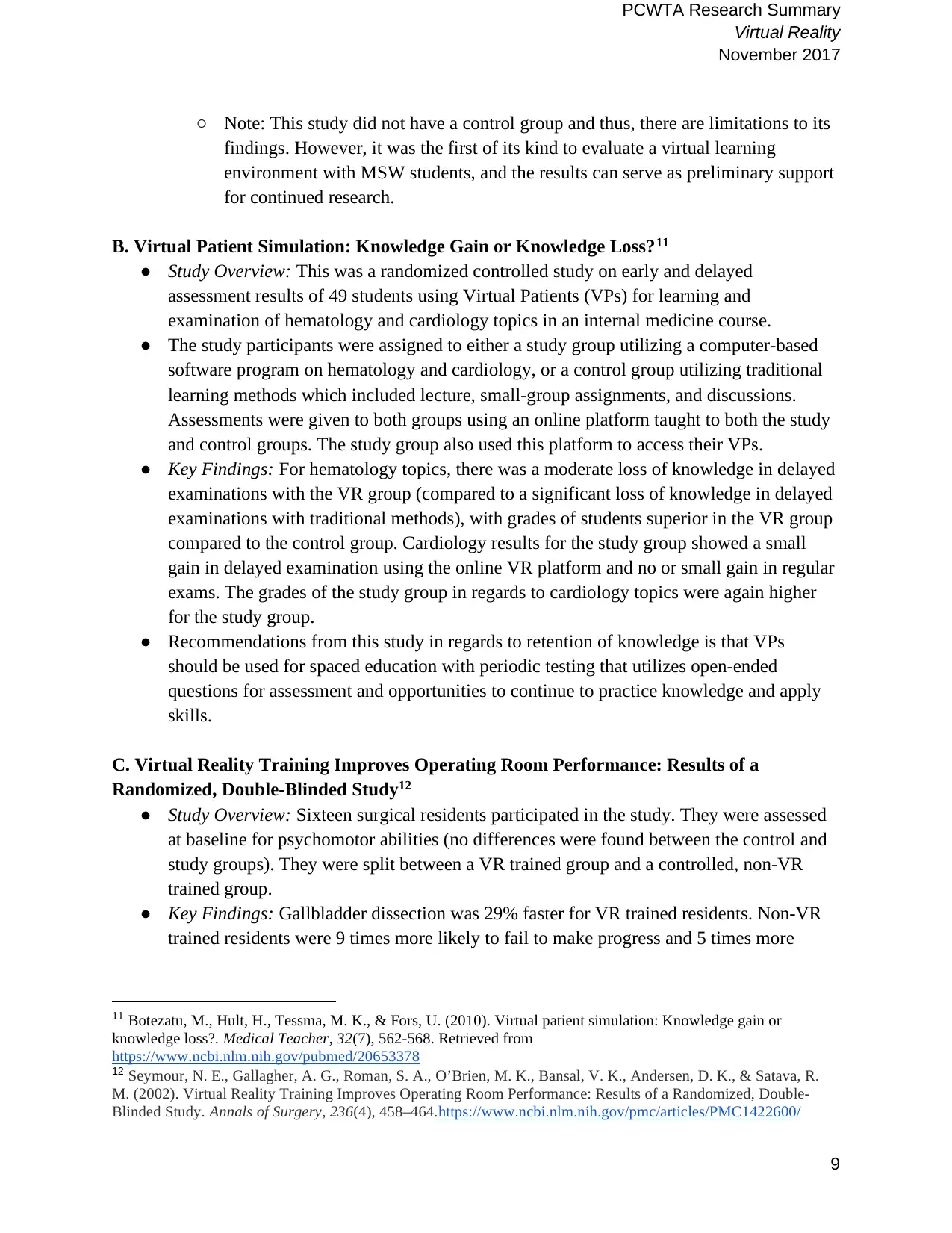
PCWTA Research Summary
Virtual Reality
November 2017
9
○ Note: This study did not have a control group and thus, there are limitations to its
findings. However, it was the first of its kind to evaluate a virtual learning
environment with MSW students, and the results can serve as preliminary support
for continued research.
B. Virtual Patient Simulation: Knowledge Gain or Knowledge Loss?11
● Study Overview: This was a randomized controlled study on early and delayed
assessment results of 49 students using Virtual Patients (VPs) for learning and
examination of hematology and cardiology topics in an internal medicine course.
● The study participants were assigned to either a study group utilizing a computer-based
software program on hematology and cardiology, or a control group utilizing traditional
learning methods which included lecture, small-group assignments, and discussions.
Assessments were given to both groups using an online platform taught to both the study
and control groups. The study group also used this platform to access their VPs.
● Key Findings: For hematology topics, there was a moderate loss of knowledge in delayed
examinations with the VR group (compared to a significant loss of knowledge in delayed
examinations with traditional methods), with grades of students superior in the VR group
compared to the control group. Cardiology results for the study group showed a small
gain in delayed examination using the online VR platform and no or small gain in regular
exams. The grades of the study group in regards to cardiology topics were again higher
for the study group.
● Recommendations from this study in regards to retention of knowledge is that VPs
should be used for spaced education with periodic testing that utilizes open-ended
questions for assessment and opportunities to continue to practice knowledge and apply
skills.
C. Virtual Reality Training Improves Operating Room Performance: Results of a
Randomized, Double-Blinded Study12
● Study Overview: Sixteen surgical residents participated in the study. They were assessed
at baseline for psychomotor abilities (no differences were found between the control and
study groups). They were split between a VR trained group and a controlled, non-VR
trained group.
● Key Findings: Gallbladder dissection was 29% faster for VR trained residents. Non-VR
trained residents were 9 times more likely to fail to make progress and 5 times more
11 Botezatu, M., Hult, H., Tessma, M. K., & Fors, U. (2010). Virtual patient simulation: Knowledge gain or
knowledge loss?. Medical Teacher, 32(7), 562-568. Retrieved from
https://www.ncbi.nlm.nih.gov/pubmed/20653378
12 Seymour, N. E., Gallagher, A. G., Roman, S. A., O’Brien, M. K., Bansal, V. K., Andersen, D. K., & Satava, R.
M. (2002). Virtual Reality Training Improves Operating Room Performance: Results of a Randomized, Double-
Blinded Study. Annals of Surgery, 236(4), 458–464.https://www.ncbi.nlm.nih.gov/pmc/articles/PMC1422600/
Virtual Reality
November 2017
9
○ Note: This study did not have a control group and thus, there are limitations to its
findings. However, it was the first of its kind to evaluate a virtual learning
environment with MSW students, and the results can serve as preliminary support
for continued research.
B. Virtual Patient Simulation: Knowledge Gain or Knowledge Loss?11
● Study Overview: This was a randomized controlled study on early and delayed
assessment results of 49 students using Virtual Patients (VPs) for learning and
examination of hematology and cardiology topics in an internal medicine course.
● The study participants were assigned to either a study group utilizing a computer-based
software program on hematology and cardiology, or a control group utilizing traditional
learning methods which included lecture, small-group assignments, and discussions.
Assessments were given to both groups using an online platform taught to both the study
and control groups. The study group also used this platform to access their VPs.
● Key Findings: For hematology topics, there was a moderate loss of knowledge in delayed
examinations with the VR group (compared to a significant loss of knowledge in delayed
examinations with traditional methods), with grades of students superior in the VR group
compared to the control group. Cardiology results for the study group showed a small
gain in delayed examination using the online VR platform and no or small gain in regular
exams. The grades of the study group in regards to cardiology topics were again higher
for the study group.
● Recommendations from this study in regards to retention of knowledge is that VPs
should be used for spaced education with periodic testing that utilizes open-ended
questions for assessment and opportunities to continue to practice knowledge and apply
skills.
C. Virtual Reality Training Improves Operating Room Performance: Results of a
Randomized, Double-Blinded Study12
● Study Overview: Sixteen surgical residents participated in the study. They were assessed
at baseline for psychomotor abilities (no differences were found between the control and
study groups). They were split between a VR trained group and a controlled, non-VR
trained group.
● Key Findings: Gallbladder dissection was 29% faster for VR trained residents. Non-VR
trained residents were 9 times more likely to fail to make progress and 5 times more
11 Botezatu, M., Hult, H., Tessma, M. K., & Fors, U. (2010). Virtual patient simulation: Knowledge gain or
knowledge loss?. Medical Teacher, 32(7), 562-568. Retrieved from
https://www.ncbi.nlm.nih.gov/pubmed/20653378
12 Seymour, N. E., Gallagher, A. G., Roman, S. A., O’Brien, M. K., Bansal, V. K., Andersen, D. K., & Satava, R.
M. (2002). Virtual Reality Training Improves Operating Room Performance: Results of a Randomized, Double-
Blinded Study. Annals of Surgery, 236(4), 458–464.https://www.ncbi.nlm.nih.gov/pmc/articles/PMC1422600/
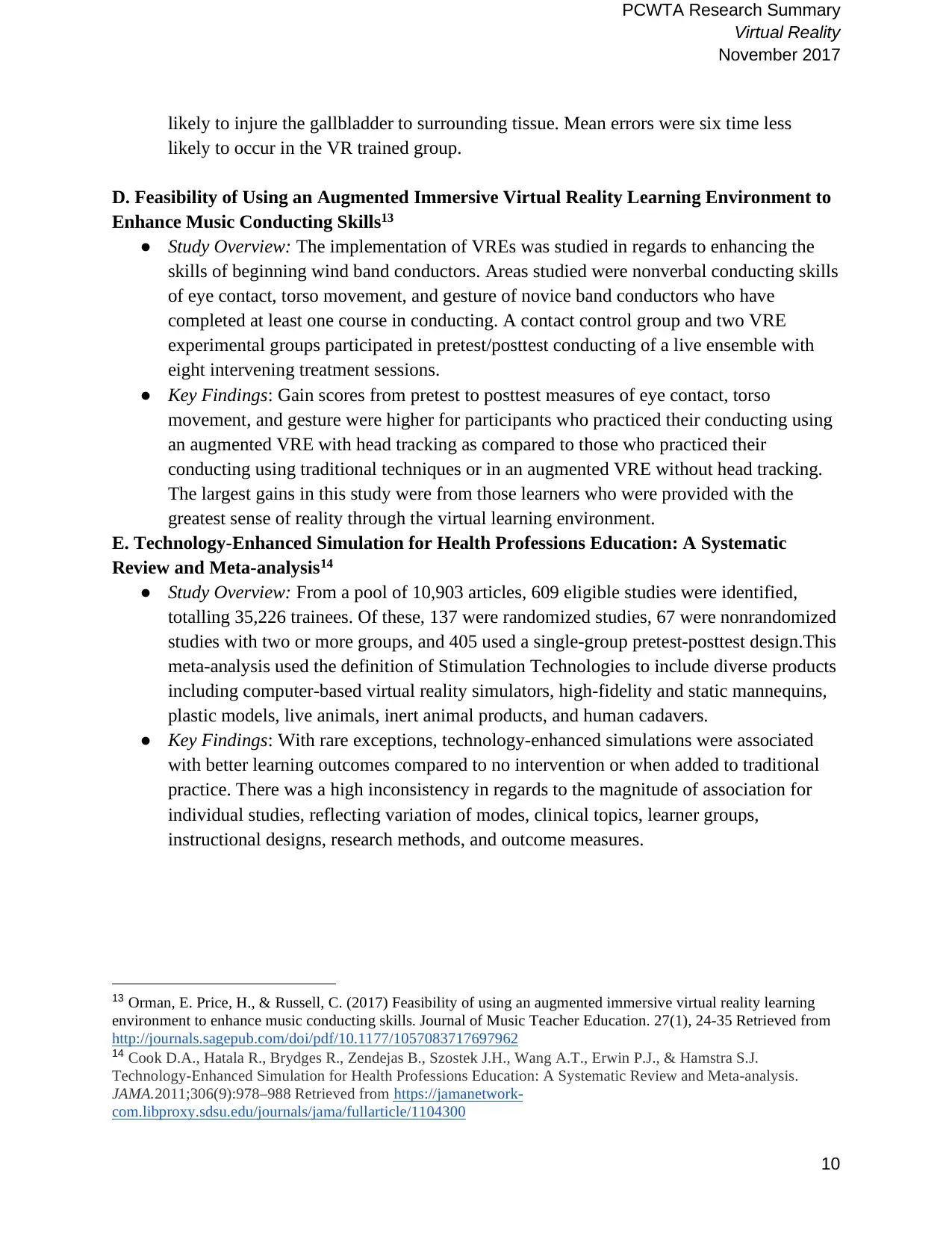
PCWTA Research Summary
Virtual Reality
November 2017
10
likely to injure the gallbladder to surrounding tissue. Mean errors were six time less
likely to occur in the VR trained group.
D. Feasibility of Using an Augmented Immersive Virtual Reality Learning Environment to
Enhance Music Conducting Skills13
● Study Overview: The implementation of VREs was studied in regards to enhancing the
skills of beginning wind band conductors. Areas studied were nonverbal conducting skills
of eye contact, torso movement, and gesture of novice band conductors who have
completed at least one course in conducting. A contact control group and two VRE
experimental groups participated in pretest/posttest conducting of a live ensemble with
eight intervening treatment sessions.
● Key Findings: Gain scores from pretest to posttest measures of eye contact, torso
movement, and gesture were higher for participants who practiced their conducting using
an augmented VRE with head tracking as compared to those who practiced their
conducting using traditional techniques or in an augmented VRE without head tracking.
The largest gains in this study were from those learners who were provided with the
greatest sense of reality through the virtual learning environment.
E. Technology-Enhanced Simulation for Health Professions Education: A Systematic
Review and Meta-analysis14
● Study Overview: From a pool of 10,903 articles, 609 eligible studies were identified,
totalling 35,226 trainees. Of these, 137 were randomized studies, 67 were nonrandomized
studies with two or more groups, and 405 used a single-group pretest-posttest design.This
meta-analysis used the definition of Stimulation Technologies to include diverse products
including computer-based virtual reality simulators, high-fidelity and static mannequins,
plastic models, live animals, inert animal products, and human cadavers.
● Key Findings: With rare exceptions, technology-enhanced simulations were associated
with better learning outcomes compared to no intervention or when added to traditional
practice. There was a high inconsistency in regards to the magnitude of association for
individual studies, reflecting variation of modes, clinical topics, learner groups,
instructional designs, research methods, and outcome measures.
13 Orman, E. Price, H., & Russell, C. (2017) Feasibility of using an augmented immersive virtual reality learning
environment to enhance music conducting skills. Journal of Music Teacher Education. 27(1), 24-35 Retrieved from
http://journals.sagepub.com/doi/pdf/10.1177/1057083717697962
14 Cook D.A., Hatala R., Brydges R., Zendejas B., Szostek J.H., Wang A.T., Erwin P.J., & Hamstra S.J.
Technology-Enhanced Simulation for Health Professions Education: A Systematic Review and Meta-analysis.
JAMA.2011;306(9):978–988 Retrieved from https://jamanetwork-
com.libproxy.sdsu.edu/journals/jama/fullarticle/1104300
Virtual Reality
November 2017
10
likely to injure the gallbladder to surrounding tissue. Mean errors were six time less
likely to occur in the VR trained group.
D. Feasibility of Using an Augmented Immersive Virtual Reality Learning Environment to
Enhance Music Conducting Skills13
● Study Overview: The implementation of VREs was studied in regards to enhancing the
skills of beginning wind band conductors. Areas studied were nonverbal conducting skills
of eye contact, torso movement, and gesture of novice band conductors who have
completed at least one course in conducting. A contact control group and two VRE
experimental groups participated in pretest/posttest conducting of a live ensemble with
eight intervening treatment sessions.
● Key Findings: Gain scores from pretest to posttest measures of eye contact, torso
movement, and gesture were higher for participants who practiced their conducting using
an augmented VRE with head tracking as compared to those who practiced their
conducting using traditional techniques or in an augmented VRE without head tracking.
The largest gains in this study were from those learners who were provided with the
greatest sense of reality through the virtual learning environment.
E. Technology-Enhanced Simulation for Health Professions Education: A Systematic
Review and Meta-analysis14
● Study Overview: From a pool of 10,903 articles, 609 eligible studies were identified,
totalling 35,226 trainees. Of these, 137 were randomized studies, 67 were nonrandomized
studies with two or more groups, and 405 used a single-group pretest-posttest design.This
meta-analysis used the definition of Stimulation Technologies to include diverse products
including computer-based virtual reality simulators, high-fidelity and static mannequins,
plastic models, live animals, inert animal products, and human cadavers.
● Key Findings: With rare exceptions, technology-enhanced simulations were associated
with better learning outcomes compared to no intervention or when added to traditional
practice. There was a high inconsistency in regards to the magnitude of association for
individual studies, reflecting variation of modes, clinical topics, learner groups,
instructional designs, research methods, and outcome measures.
13 Orman, E. Price, H., & Russell, C. (2017) Feasibility of using an augmented immersive virtual reality learning
environment to enhance music conducting skills. Journal of Music Teacher Education. 27(1), 24-35 Retrieved from
http://journals.sagepub.com/doi/pdf/10.1177/1057083717697962
14 Cook D.A., Hatala R., Brydges R., Zendejas B., Szostek J.H., Wang A.T., Erwin P.J., & Hamstra S.J.
Technology-Enhanced Simulation for Health Professions Education: A Systematic Review and Meta-analysis.
JAMA.2011;306(9):978–988 Retrieved from https://jamanetwork-
com.libproxy.sdsu.edu/journals/jama/fullarticle/1104300
Secure Best Marks with AI Grader
Need help grading? Try our AI Grader for instant feedback on your assignments.
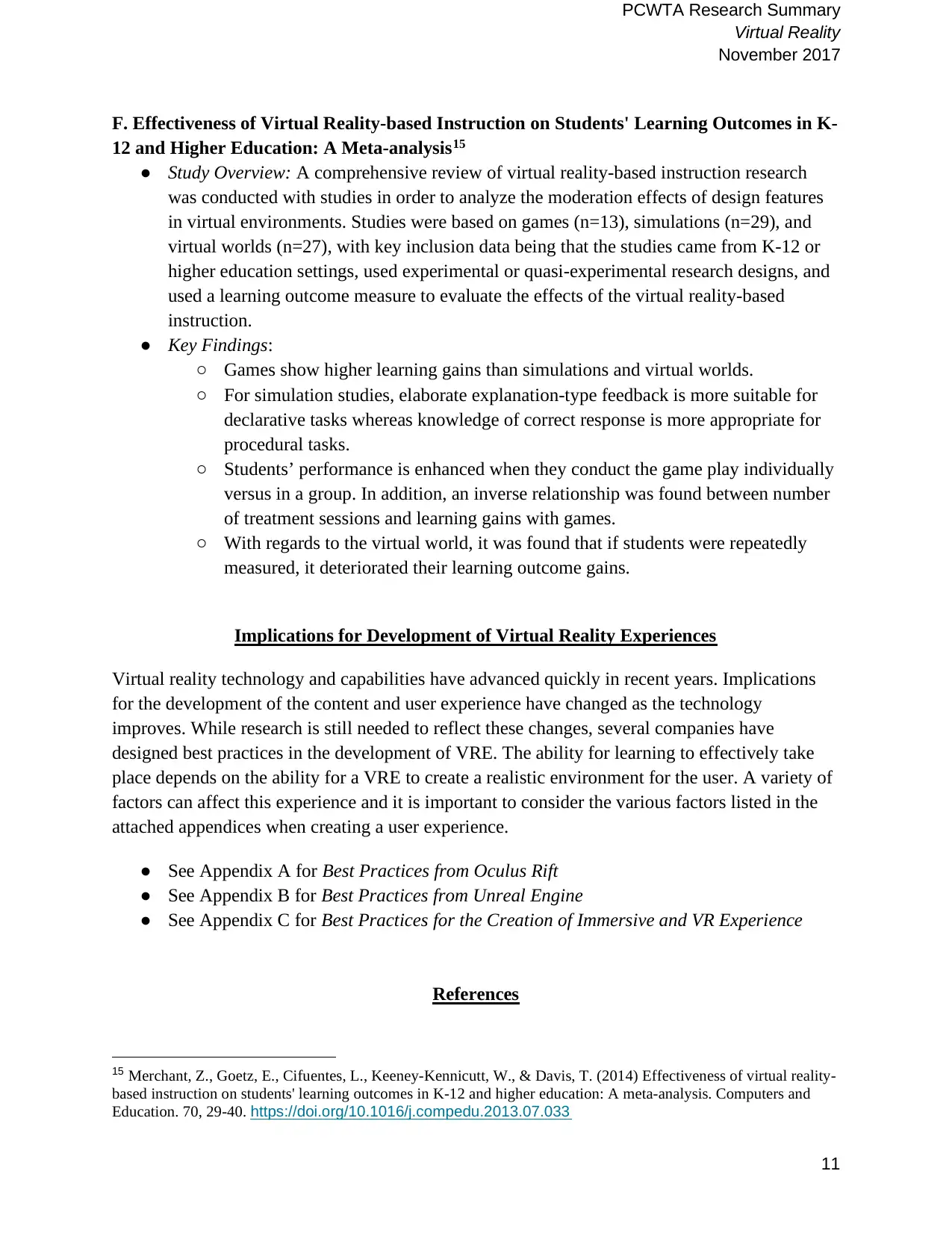
PCWTA Research Summary
Virtual Reality
November 2017
11
F. Effectiveness of Virtual Reality-based Instruction on Students' Learning Outcomes in K-
12 and Higher Education: A Meta-analysis15
● Study Overview: A comprehensive review of virtual reality-based instruction research
was conducted with studies in order to analyze the moderation effects of design features
in virtual environments. Studies were based on games (n=13), simulations (n=29), and
virtual worlds (n=27), with key inclusion data being that the studies came from K-12 or
higher education settings, used experimental or quasi-experimental research designs, and
used a learning outcome measure to evaluate the effects of the virtual reality-based
instruction.
● Key Findings:
○ Games show higher learning gains than simulations and virtual worlds.
○ For simulation studies, elaborate explanation-type feedback is more suitable for
declarative tasks whereas knowledge of correct response is more appropriate for
procedural tasks.
○ Students’ performance is enhanced when they conduct the game play individually
versus in a group. In addition, an inverse relationship was found between number
of treatment sessions and learning gains with games.
○ With regards to the virtual world, it was found that if students were repeatedly
measured, it deteriorated their learning outcome gains.
Implications for Development of Virtual Reality Experiences
Virtual reality technology and capabilities have advanced quickly in recent years. Implications
for the development of the content and user experience have changed as the technology
improves. While research is still needed to reflect these changes, several companies have
designed best practices in the development of VRE. The ability for learning to effectively take
place depends on the ability for a VRE to create a realistic environment for the user. A variety of
factors can affect this experience and it is important to consider the various factors listed in the
attached appendices when creating a user experience.
● See Appendix A for Best Practices from Oculus Rift
● See Appendix B for Best Practices from Unreal Engine
● See Appendix C for Best Practices for the Creation of Immersive and VR Experience
References
15 Merchant, Z., Goetz, E., Cifuentes, L., Keeney-Kennicutt, W., & Davis, T. (2014) Effectiveness of virtual reality-
based instruction on students' learning outcomes in K-12 and higher education: A meta-analysis. Computers and
Education. 70, 29-40. https://doi.org/10.1016/j.compedu.2013.07.033
Virtual Reality
November 2017
11
F. Effectiveness of Virtual Reality-based Instruction on Students' Learning Outcomes in K-
12 and Higher Education: A Meta-analysis15
● Study Overview: A comprehensive review of virtual reality-based instruction research
was conducted with studies in order to analyze the moderation effects of design features
in virtual environments. Studies were based on games (n=13), simulations (n=29), and
virtual worlds (n=27), with key inclusion data being that the studies came from K-12 or
higher education settings, used experimental or quasi-experimental research designs, and
used a learning outcome measure to evaluate the effects of the virtual reality-based
instruction.
● Key Findings:
○ Games show higher learning gains than simulations and virtual worlds.
○ For simulation studies, elaborate explanation-type feedback is more suitable for
declarative tasks whereas knowledge of correct response is more appropriate for
procedural tasks.
○ Students’ performance is enhanced when they conduct the game play individually
versus in a group. In addition, an inverse relationship was found between number
of treatment sessions and learning gains with games.
○ With regards to the virtual world, it was found that if students were repeatedly
measured, it deteriorated their learning outcome gains.
Implications for Development of Virtual Reality Experiences
Virtual reality technology and capabilities have advanced quickly in recent years. Implications
for the development of the content and user experience have changed as the technology
improves. While research is still needed to reflect these changes, several companies have
designed best practices in the development of VRE. The ability for learning to effectively take
place depends on the ability for a VRE to create a realistic environment for the user. A variety of
factors can affect this experience and it is important to consider the various factors listed in the
attached appendices when creating a user experience.
● See Appendix A for Best Practices from Oculus Rift
● See Appendix B for Best Practices from Unreal Engine
● See Appendix C for Best Practices for the Creation of Immersive and VR Experience
References
15 Merchant, Z., Goetz, E., Cifuentes, L., Keeney-Kennicutt, W., & Davis, T. (2014) Effectiveness of virtual reality-
based instruction on students' learning outcomes in K-12 and higher education: A meta-analysis. Computers and
Education. 70, 29-40. https://doi.org/10.1016/j.compedu.2013.07.033
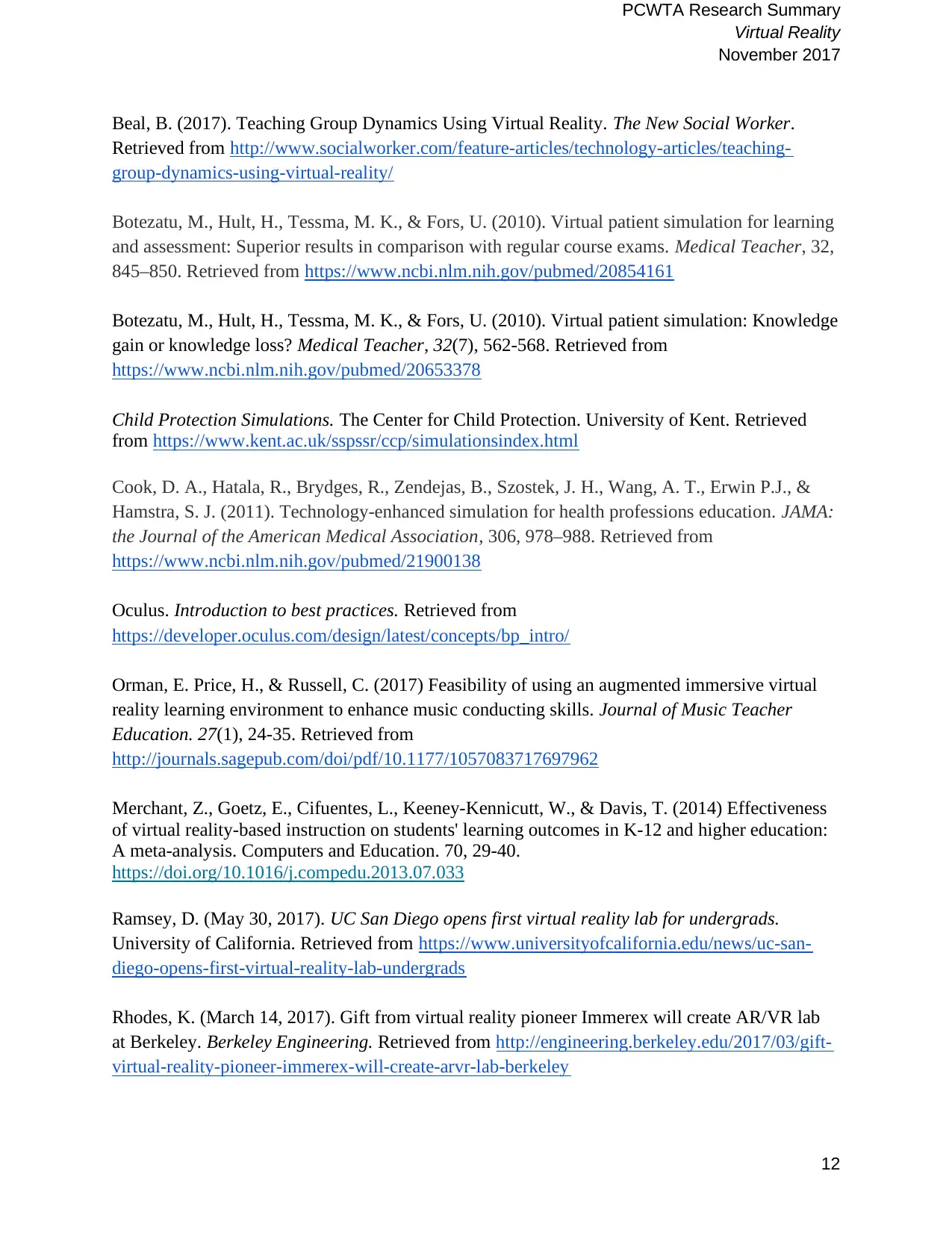
PCWTA Research Summary
Virtual Reality
November 2017
12
Beal, B. (2017). Teaching Group Dynamics Using Virtual Reality. The New Social Worker.
Retrieved from http://www.socialworker.com/feature-articles/technology-articles/teaching-
group-dynamics-using-virtual-reality/
Botezatu, M., Hult, H., Tessma, M. K., & Fors, U. (2010). Virtual patient simulation for learning
and assessment: Superior results in comparison with regular course exams. Medical Teacher, 32,
845–850. Retrieved from https://www.ncbi.nlm.nih.gov/pubmed/20854161
Botezatu, M., Hult, H., Tessma, M. K., & Fors, U. (2010). Virtual patient simulation: Knowledge
gain or knowledge loss? Medical Teacher, 32(7), 562-568. Retrieved from
https://www.ncbi.nlm.nih.gov/pubmed/20653378
Child Protection Simulations. The Center for Child Protection. University of Kent. Retrieved
from https://www.kent.ac.uk/sspssr/ccp/simulationsindex.html
Cook, D. A., Hatala, R., Brydges, R., Zendejas, B., Szostek, J. H., Wang, A. T., Erwin P.J., &
Hamstra, S. J. (2011). Technology-enhanced simulation for health professions education. JAMA:
the Journal of the American Medical Association, 306, 978–988. Retrieved from
https://www.ncbi.nlm.nih.gov/pubmed/21900138
Oculus. Introduction to best practices. Retrieved from
https://developer.oculus.com/design/latest/concepts/bp_intro/
Orman, E. Price, H., & Russell, C. (2017) Feasibility of using an augmented immersive virtual
reality learning environment to enhance music conducting skills. Journal of Music Teacher
Education. 27(1), 24-35. Retrieved from
http://journals.sagepub.com/doi/pdf/10.1177/1057083717697962
Merchant, Z., Goetz, E., Cifuentes, L., Keeney-Kennicutt, W., & Davis, T. (2014) Effectiveness
of virtual reality-based instruction on students' learning outcomes in K-12 and higher education:
A meta-analysis. Computers and Education. 70, 29-40.
https://doi.org/10.1016/j.compedu.2013.07.033
Ramsey, D. (May 30, 2017). UC San Diego opens first virtual reality lab for undergrads.
University of California. Retrieved from https://www.universityofcalifornia.edu/news/uc-san-
diego-opens-first-virtual-reality-lab-undergrads
Rhodes, K. (March 14, 2017). Gift from virtual reality pioneer Immerex will create AR/VR lab
at Berkeley. Berkeley Engineering. Retrieved from http://engineering.berkeley.edu/2017/03/gift-
virtual-reality-pioneer-immerex-will-create-arvr-lab-berkeley
Virtual Reality
November 2017
12
Beal, B. (2017). Teaching Group Dynamics Using Virtual Reality. The New Social Worker.
Retrieved from http://www.socialworker.com/feature-articles/technology-articles/teaching-
group-dynamics-using-virtual-reality/
Botezatu, M., Hult, H., Tessma, M. K., & Fors, U. (2010). Virtual patient simulation for learning
and assessment: Superior results in comparison with regular course exams. Medical Teacher, 32,
845–850. Retrieved from https://www.ncbi.nlm.nih.gov/pubmed/20854161
Botezatu, M., Hult, H., Tessma, M. K., & Fors, U. (2010). Virtual patient simulation: Knowledge
gain or knowledge loss? Medical Teacher, 32(7), 562-568. Retrieved from
https://www.ncbi.nlm.nih.gov/pubmed/20653378
Child Protection Simulations. The Center for Child Protection. University of Kent. Retrieved
from https://www.kent.ac.uk/sspssr/ccp/simulationsindex.html
Cook, D. A., Hatala, R., Brydges, R., Zendejas, B., Szostek, J. H., Wang, A. T., Erwin P.J., &
Hamstra, S. J. (2011). Technology-enhanced simulation for health professions education. JAMA:
the Journal of the American Medical Association, 306, 978–988. Retrieved from
https://www.ncbi.nlm.nih.gov/pubmed/21900138
Oculus. Introduction to best practices. Retrieved from
https://developer.oculus.com/design/latest/concepts/bp_intro/
Orman, E. Price, H., & Russell, C. (2017) Feasibility of using an augmented immersive virtual
reality learning environment to enhance music conducting skills. Journal of Music Teacher
Education. 27(1), 24-35. Retrieved from
http://journals.sagepub.com/doi/pdf/10.1177/1057083717697962
Merchant, Z., Goetz, E., Cifuentes, L., Keeney-Kennicutt, W., & Davis, T. (2014) Effectiveness
of virtual reality-based instruction on students' learning outcomes in K-12 and higher education:
A meta-analysis. Computers and Education. 70, 29-40.
https://doi.org/10.1016/j.compedu.2013.07.033
Ramsey, D. (May 30, 2017). UC San Diego opens first virtual reality lab for undergrads.
University of California. Retrieved from https://www.universityofcalifornia.edu/news/uc-san-
diego-opens-first-virtual-reality-lab-undergrads
Rhodes, K. (March 14, 2017). Gift from virtual reality pioneer Immerex will create AR/VR lab
at Berkeley. Berkeley Engineering. Retrieved from http://engineering.berkeley.edu/2017/03/gift-
virtual-reality-pioneer-immerex-will-create-arvr-lab-berkeley
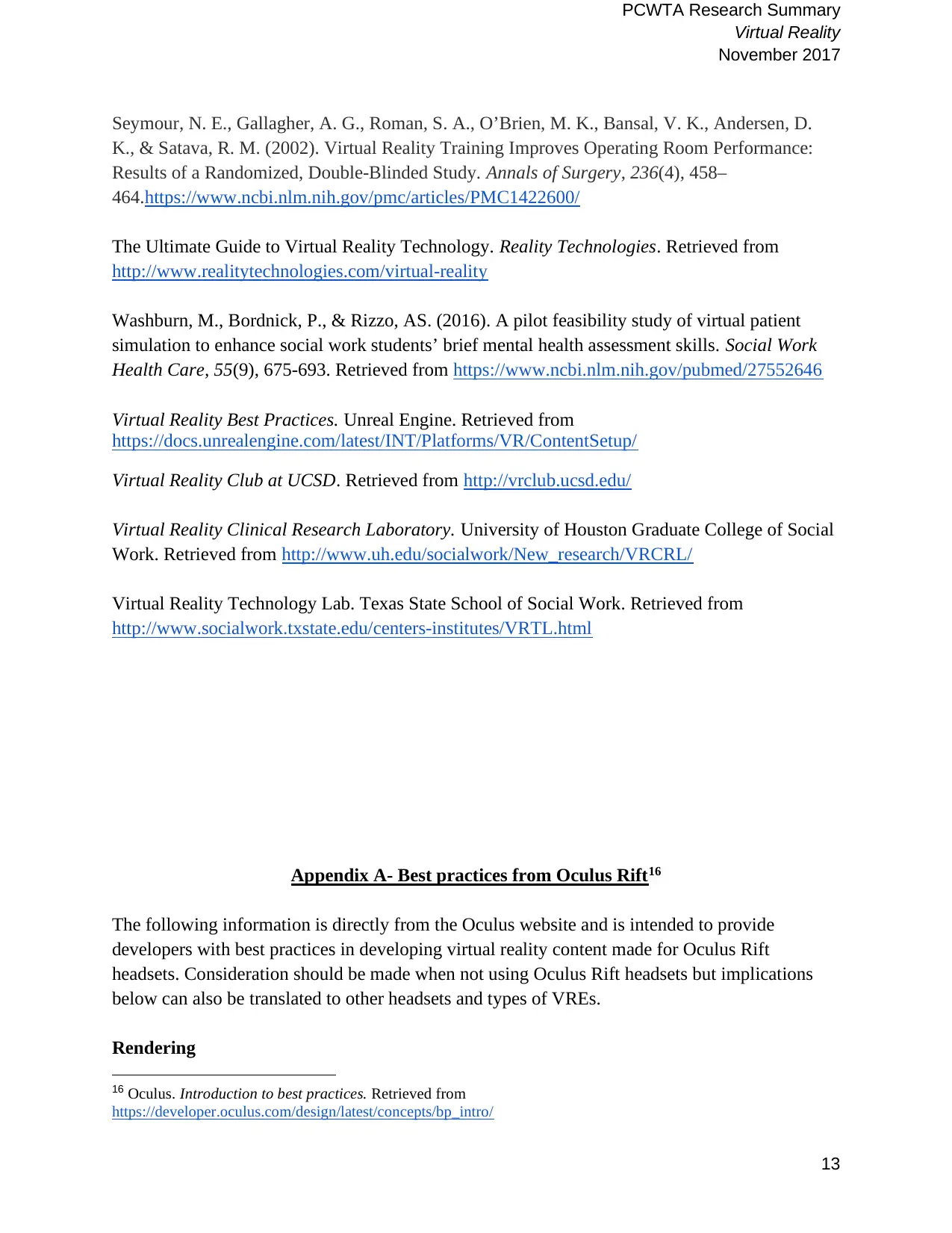
PCWTA Research Summary
Virtual Reality
November 2017
13
Seymour, N. E., Gallagher, A. G., Roman, S. A., O’Brien, M. K., Bansal, V. K., Andersen, D.
K., & Satava, R. M. (2002). Virtual Reality Training Improves Operating Room Performance:
Results of a Randomized, Double-Blinded Study. Annals of Surgery, 236(4), 458–
464.https://www.ncbi.nlm.nih.gov/pmc/articles/PMC1422600/
The Ultimate Guide to Virtual Reality Technology. Reality Technologies. Retrieved from
http://www.realitytechnologies.com/virtual-reality
Washburn, M., Bordnick, P., & Rizzo, AS. (2016). A pilot feasibility study of virtual patient
simulation to enhance social work students’ brief mental health assessment skills. Social Work
Health Care, 55(9), 675-693. Retrieved from https://www.ncbi.nlm.nih.gov/pubmed/27552646
Virtual Reality Best Practices. Unreal Engine. Retrieved from
https://docs.unrealengine.com/latest/INT/Platforms/VR/ContentSetup/
Virtual Reality Club at UCSD. Retrieved from http://vrclub.ucsd.edu/
Virtual Reality Clinical Research Laboratory. University of Houston Graduate College of Social
Work. Retrieved from http://www.uh.edu/socialwork/New_research/VRCRL/
Virtual Reality Technology Lab. Texas State School of Social Work. Retrieved from
http://www.socialwork.txstate.edu/centers-institutes/VRTL.html
Appendix A- Best practices from Oculus Rift16
The following information is directly from the Oculus website and is intended to provide
developers with best practices in developing virtual reality content made for Oculus Rift
headsets. Consideration should be made when not using Oculus Rift headsets but implications
below can also be translated to other headsets and types of VREs.
Rendering
16 Oculus. Introduction to best practices. Retrieved from
https://developer.oculus.com/design/latest/concepts/bp_intro/
Virtual Reality
November 2017
13
Seymour, N. E., Gallagher, A. G., Roman, S. A., O’Brien, M. K., Bansal, V. K., Andersen, D.
K., & Satava, R. M. (2002). Virtual Reality Training Improves Operating Room Performance:
Results of a Randomized, Double-Blinded Study. Annals of Surgery, 236(4), 458–
464.https://www.ncbi.nlm.nih.gov/pmc/articles/PMC1422600/
The Ultimate Guide to Virtual Reality Technology. Reality Technologies. Retrieved from
http://www.realitytechnologies.com/virtual-reality
Washburn, M., Bordnick, P., & Rizzo, AS. (2016). A pilot feasibility study of virtual patient
simulation to enhance social work students’ brief mental health assessment skills. Social Work
Health Care, 55(9), 675-693. Retrieved from https://www.ncbi.nlm.nih.gov/pubmed/27552646
Virtual Reality Best Practices. Unreal Engine. Retrieved from
https://docs.unrealengine.com/latest/INT/Platforms/VR/ContentSetup/
Virtual Reality Club at UCSD. Retrieved from http://vrclub.ucsd.edu/
Virtual Reality Clinical Research Laboratory. University of Houston Graduate College of Social
Work. Retrieved from http://www.uh.edu/socialwork/New_research/VRCRL/
Virtual Reality Technology Lab. Texas State School of Social Work. Retrieved from
http://www.socialwork.txstate.edu/centers-institutes/VRTL.html
Appendix A- Best practices from Oculus Rift16
The following information is directly from the Oculus website and is intended to provide
developers with best practices in developing virtual reality content made for Oculus Rift
headsets. Consideration should be made when not using Oculus Rift headsets but implications
below can also be translated to other headsets and types of VREs.
Rendering
16 Oculus. Introduction to best practices. Retrieved from
https://developer.oculus.com/design/latest/concepts/bp_intro/
Paraphrase This Document
Need a fresh take? Get an instant paraphrase of this document with our AI Paraphraser
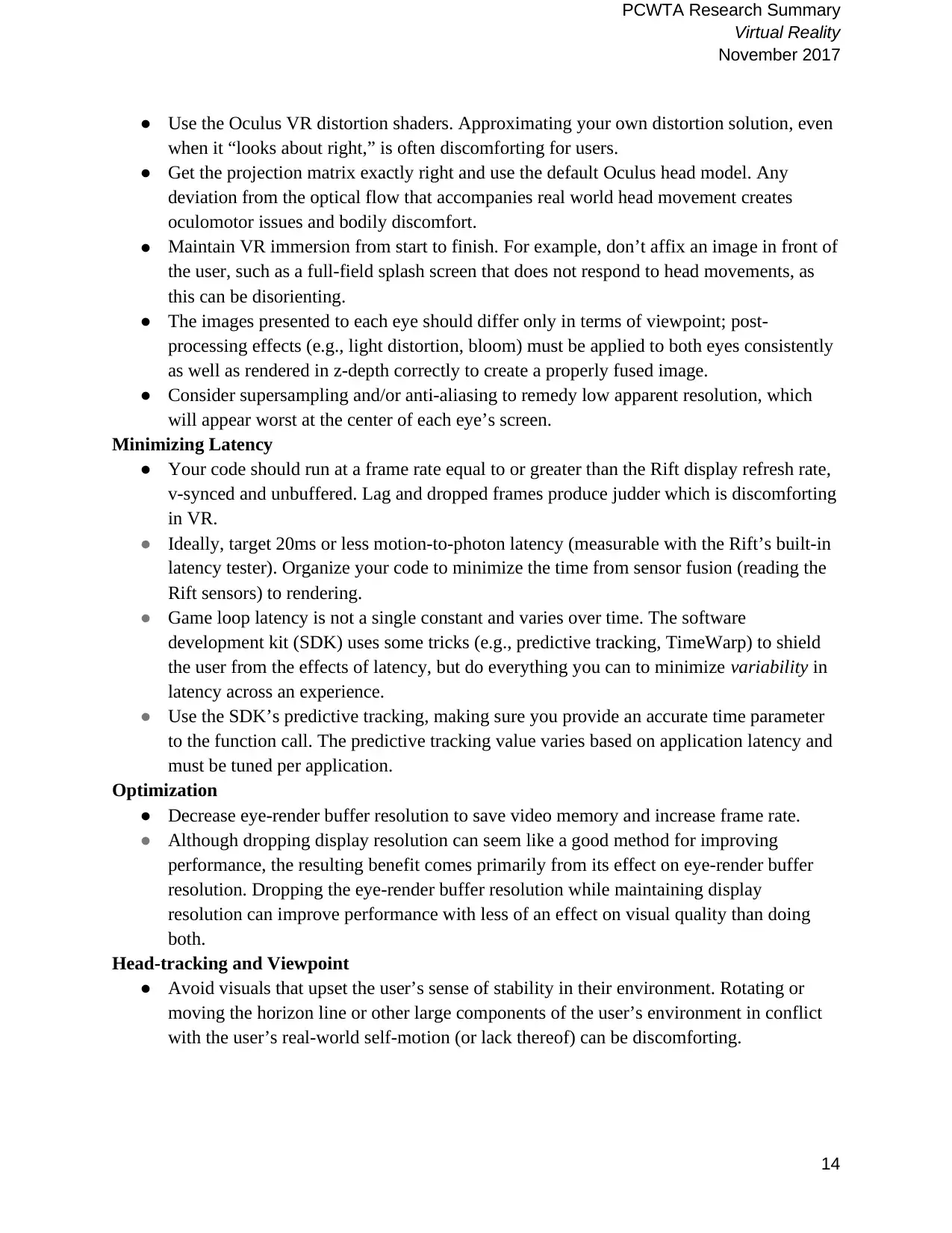
PCWTA Research Summary
Virtual Reality
November 2017
14
● Use the Oculus VR distortion shaders. Approximating your own distortion solution, even
when it “looks about right,” is often discomforting for users.
● Get the projection matrix exactly right and use the default Oculus head model. Any
deviation from the optical flow that accompanies real world head movement creates
oculomotor issues and bodily discomfort.
● Maintain VR immersion from start to finish. For example, don’t affix an image in front of
the user, such as a full-field splash screen that does not respond to head movements, as
this can be disorienting.
● The images presented to each eye should differ only in terms of viewpoint; post-
processing effects (e.g., light distortion, bloom) must be applied to both eyes consistently
as well as rendered in z-depth correctly to create a properly fused image.
● Consider supersampling and/or anti-aliasing to remedy low apparent resolution, which
will appear worst at the center of each eye’s screen.
Minimizing Latency
● Your code should run at a frame rate equal to or greater than the Rift display refresh rate,
v-synced and unbuffered. Lag and dropped frames produce judder which is discomforting
in VR.
● Ideally, target 20ms or less motion-to-photon latency (measurable with the Rift’s built-in
latency tester). Organize your code to minimize the time from sensor fusion (reading the
Rift sensors) to rendering.
● Game loop latency is not a single constant and varies over time. The software
development kit (SDK) uses some tricks (e.g., predictive tracking, TimeWarp) to shield
the user from the effects of latency, but do everything you can to minimize variability in
latency across an experience.
● Use the SDK’s predictive tracking, making sure you provide an accurate time parameter
to the function call. The predictive tracking value varies based on application latency and
must be tuned per application.
Optimization
● Decrease eye-render buffer resolution to save video memory and increase frame rate.
● Although dropping display resolution can seem like a good method for improving
performance, the resulting benefit comes primarily from its effect on eye-render buffer
resolution. Dropping the eye-render buffer resolution while maintaining display
resolution can improve performance with less of an effect on visual quality than doing
both.
Head-tracking and Viewpoint
● Avoid visuals that upset the user’s sense of stability in their environment. Rotating or
moving the horizon line or other large components of the user’s environment in conflict
with the user’s real-world self-motion (or lack thereof) can be discomforting.
Virtual Reality
November 2017
14
● Use the Oculus VR distortion shaders. Approximating your own distortion solution, even
when it “looks about right,” is often discomforting for users.
● Get the projection matrix exactly right and use the default Oculus head model. Any
deviation from the optical flow that accompanies real world head movement creates
oculomotor issues and bodily discomfort.
● Maintain VR immersion from start to finish. For example, don’t affix an image in front of
the user, such as a full-field splash screen that does not respond to head movements, as
this can be disorienting.
● The images presented to each eye should differ only in terms of viewpoint; post-
processing effects (e.g., light distortion, bloom) must be applied to both eyes consistently
as well as rendered in z-depth correctly to create a properly fused image.
● Consider supersampling and/or anti-aliasing to remedy low apparent resolution, which
will appear worst at the center of each eye’s screen.
Minimizing Latency
● Your code should run at a frame rate equal to or greater than the Rift display refresh rate,
v-synced and unbuffered. Lag and dropped frames produce judder which is discomforting
in VR.
● Ideally, target 20ms or less motion-to-photon latency (measurable with the Rift’s built-in
latency tester). Organize your code to minimize the time from sensor fusion (reading the
Rift sensors) to rendering.
● Game loop latency is not a single constant and varies over time. The software
development kit (SDK) uses some tricks (e.g., predictive tracking, TimeWarp) to shield
the user from the effects of latency, but do everything you can to minimize variability in
latency across an experience.
● Use the SDK’s predictive tracking, making sure you provide an accurate time parameter
to the function call. The predictive tracking value varies based on application latency and
must be tuned per application.
Optimization
● Decrease eye-render buffer resolution to save video memory and increase frame rate.
● Although dropping display resolution can seem like a good method for improving
performance, the resulting benefit comes primarily from its effect on eye-render buffer
resolution. Dropping the eye-render buffer resolution while maintaining display
resolution can improve performance with less of an effect on visual quality than doing
both.
Head-tracking and Viewpoint
● Avoid visuals that upset the user’s sense of stability in their environment. Rotating or
moving the horizon line or other large components of the user’s environment in conflict
with the user’s real-world self-motion (or lack thereof) can be discomforting.
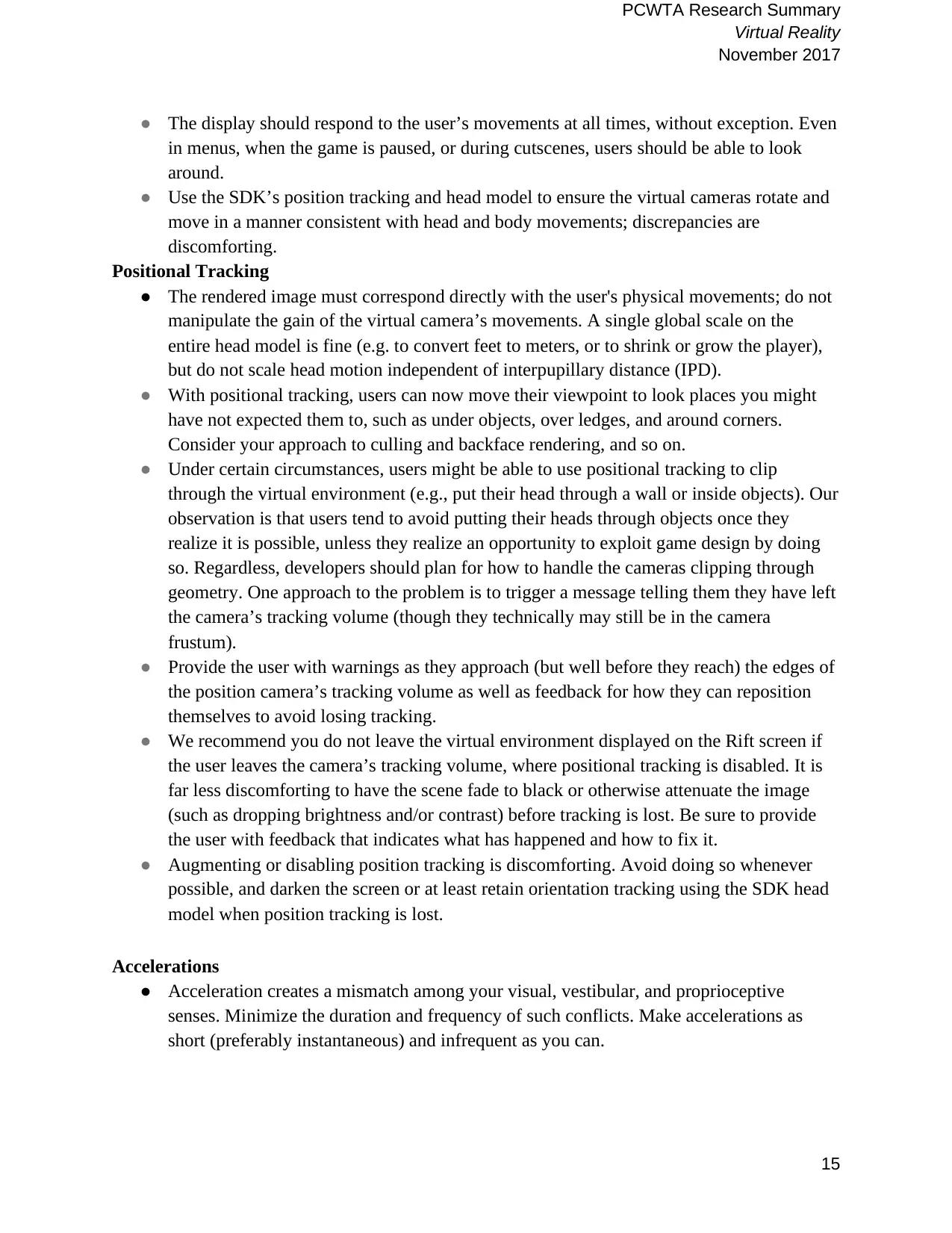
PCWTA Research Summary
Virtual Reality
November 2017
15
● The display should respond to the user’s movements at all times, without exception. Even
in menus, when the game is paused, or during cutscenes, users should be able to look
around.
● Use the SDK’s position tracking and head model to ensure the virtual cameras rotate and
move in a manner consistent with head and body movements; discrepancies are
discomforting.
Positional Tracking
● The rendered image must correspond directly with the user's physical movements; do not
manipulate the gain of the virtual camera’s movements. A single global scale on the
entire head model is fine (e.g. to convert feet to meters, or to shrink or grow the player),
but do not scale head motion independent of interpupillary distance (IPD).
● With positional tracking, users can now move their viewpoint to look places you might
have not expected them to, such as under objects, over ledges, and around corners.
Consider your approach to culling and backface rendering, and so on.
● Under certain circumstances, users might be able to use positional tracking to clip
through the virtual environment (e.g., put their head through a wall or inside objects). Our
observation is that users tend to avoid putting their heads through objects once they
realize it is possible, unless they realize an opportunity to exploit game design by doing
so. Regardless, developers should plan for how to handle the cameras clipping through
geometry. One approach to the problem is to trigger a message telling them they have left
the camera’s tracking volume (though they technically may still be in the camera
frustum).
● Provide the user with warnings as they approach (but well before they reach) the edges of
the position camera’s tracking volume as well as feedback for how they can reposition
themselves to avoid losing tracking.
● We recommend you do not leave the virtual environment displayed on the Rift screen if
the user leaves the camera’s tracking volume, where positional tracking is disabled. It is
far less discomforting to have the scene fade to black or otherwise attenuate the image
(such as dropping brightness and/or contrast) before tracking is lost. Be sure to provide
the user with feedback that indicates what has happened and how to fix it.
● Augmenting or disabling position tracking is discomforting. Avoid doing so whenever
possible, and darken the screen or at least retain orientation tracking using the SDK head
model when position tracking is lost.
Accelerations
● Acceleration creates a mismatch among your visual, vestibular, and proprioceptive
senses. Minimize the duration and frequency of such conflicts. Make accelerations as
short (preferably instantaneous) and infrequent as you can.
Virtual Reality
November 2017
15
● The display should respond to the user’s movements at all times, without exception. Even
in menus, when the game is paused, or during cutscenes, users should be able to look
around.
● Use the SDK’s position tracking and head model to ensure the virtual cameras rotate and
move in a manner consistent with head and body movements; discrepancies are
discomforting.
Positional Tracking
● The rendered image must correspond directly with the user's physical movements; do not
manipulate the gain of the virtual camera’s movements. A single global scale on the
entire head model is fine (e.g. to convert feet to meters, or to shrink or grow the player),
but do not scale head motion independent of interpupillary distance (IPD).
● With positional tracking, users can now move their viewpoint to look places you might
have not expected them to, such as under objects, over ledges, and around corners.
Consider your approach to culling and backface rendering, and so on.
● Under certain circumstances, users might be able to use positional tracking to clip
through the virtual environment (e.g., put their head through a wall or inside objects). Our
observation is that users tend to avoid putting their heads through objects once they
realize it is possible, unless they realize an opportunity to exploit game design by doing
so. Regardless, developers should plan for how to handle the cameras clipping through
geometry. One approach to the problem is to trigger a message telling them they have left
the camera’s tracking volume (though they technically may still be in the camera
frustum).
● Provide the user with warnings as they approach (but well before they reach) the edges of
the position camera’s tracking volume as well as feedback for how they can reposition
themselves to avoid losing tracking.
● We recommend you do not leave the virtual environment displayed on the Rift screen if
the user leaves the camera’s tracking volume, where positional tracking is disabled. It is
far less discomforting to have the scene fade to black or otherwise attenuate the image
(such as dropping brightness and/or contrast) before tracking is lost. Be sure to provide
the user with feedback that indicates what has happened and how to fix it.
● Augmenting or disabling position tracking is discomforting. Avoid doing so whenever
possible, and darken the screen or at least retain orientation tracking using the SDK head
model when position tracking is lost.
Accelerations
● Acceleration creates a mismatch among your visual, vestibular, and proprioceptive
senses. Minimize the duration and frequency of such conflicts. Make accelerations as
short (preferably instantaneous) and infrequent as you can.
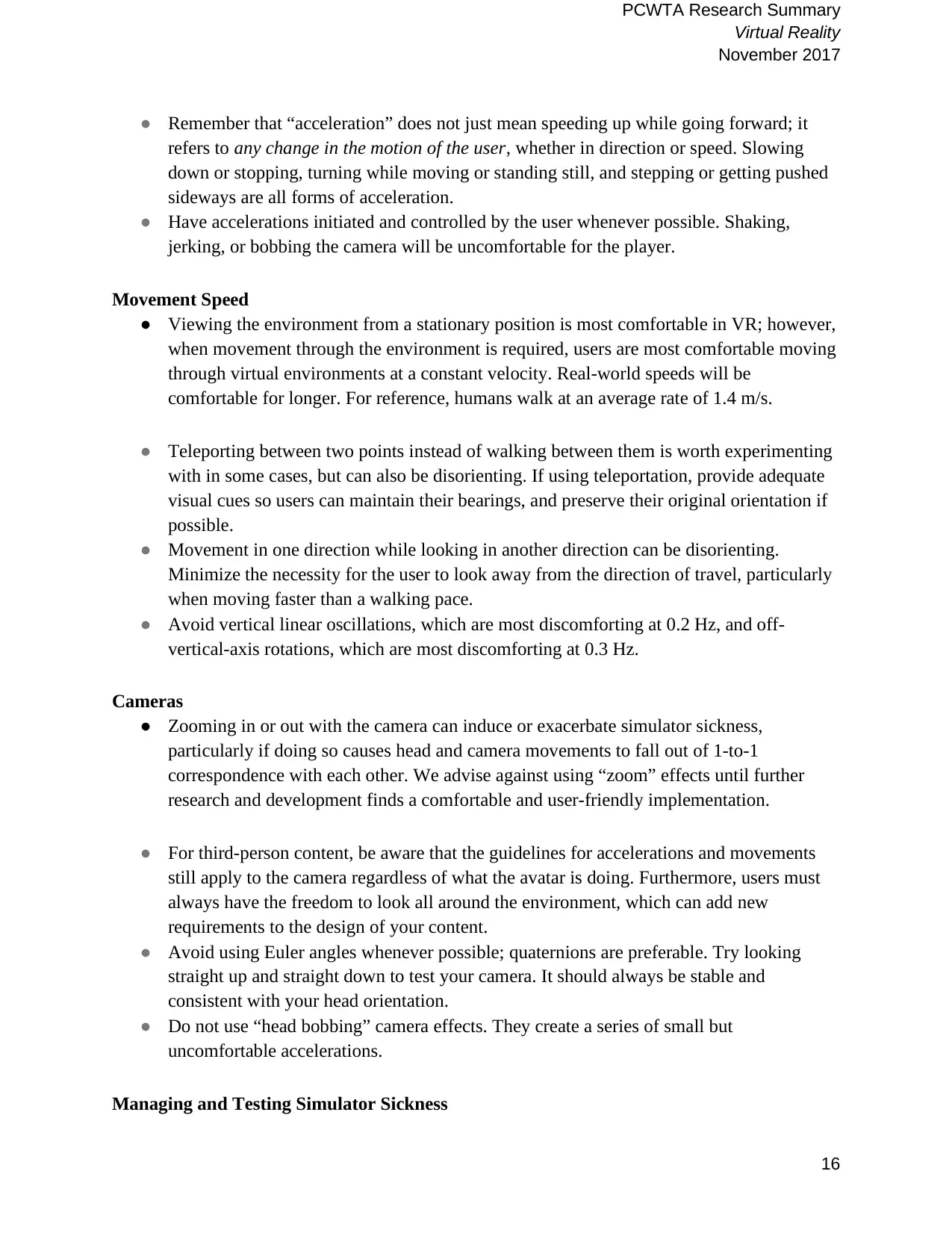
PCWTA Research Summary
Virtual Reality
November 2017
16
● Remember that “acceleration” does not just mean speeding up while going forward; it
refers to any change in the motion of the user, whether in direction or speed. Slowing
down or stopping, turning while moving or standing still, and stepping or getting pushed
sideways are all forms of acceleration.
● Have accelerations initiated and controlled by the user whenever possible. Shaking,
jerking, or bobbing the camera will be uncomfortable for the player.
Movement Speed
● Viewing the environment from a stationary position is most comfortable in VR; however,
when movement through the environment is required, users are most comfortable moving
through virtual environments at a constant velocity. Real-world speeds will be
comfortable for longer. For reference, humans walk at an average rate of 1.4 m/s.
● Teleporting between two points instead of walking between them is worth experimenting
with in some cases, but can also be disorienting. If using teleportation, provide adequate
visual cues so users can maintain their bearings, and preserve their original orientation if
possible.
● Movement in one direction while looking in another direction can be disorienting.
Minimize the necessity for the user to look away from the direction of travel, particularly
when moving faster than a walking pace.
● Avoid vertical linear oscillations, which are most discomforting at 0.2 Hz, and off-
vertical-axis rotations, which are most discomforting at 0.3 Hz.
Cameras
● Zooming in or out with the camera can induce or exacerbate simulator sickness,
particularly if doing so causes head and camera movements to fall out of 1-to-1
correspondence with each other. We advise against using “zoom” effects until further
research and development finds a comfortable and user-friendly implementation.
● For third-person content, be aware that the guidelines for accelerations and movements
still apply to the camera regardless of what the avatar is doing. Furthermore, users must
always have the freedom to look all around the environment, which can add new
requirements to the design of your content.
● Avoid using Euler angles whenever possible; quaternions are preferable. Try looking
straight up and straight down to test your camera. It should always be stable and
consistent with your head orientation.
● Do not use “head bobbing” camera effects. They create a series of small but
uncomfortable accelerations.
Managing and Testing Simulator Sickness
Virtual Reality
November 2017
16
● Remember that “acceleration” does not just mean speeding up while going forward; it
refers to any change in the motion of the user, whether in direction or speed. Slowing
down or stopping, turning while moving or standing still, and stepping or getting pushed
sideways are all forms of acceleration.
● Have accelerations initiated and controlled by the user whenever possible. Shaking,
jerking, or bobbing the camera will be uncomfortable for the player.
Movement Speed
● Viewing the environment from a stationary position is most comfortable in VR; however,
when movement through the environment is required, users are most comfortable moving
through virtual environments at a constant velocity. Real-world speeds will be
comfortable for longer. For reference, humans walk at an average rate of 1.4 m/s.
● Teleporting between two points instead of walking between them is worth experimenting
with in some cases, but can also be disorienting. If using teleportation, provide adequate
visual cues so users can maintain their bearings, and preserve their original orientation if
possible.
● Movement in one direction while looking in another direction can be disorienting.
Minimize the necessity for the user to look away from the direction of travel, particularly
when moving faster than a walking pace.
● Avoid vertical linear oscillations, which are most discomforting at 0.2 Hz, and off-
vertical-axis rotations, which are most discomforting at 0.3 Hz.
Cameras
● Zooming in or out with the camera can induce or exacerbate simulator sickness,
particularly if doing so causes head and camera movements to fall out of 1-to-1
correspondence with each other. We advise against using “zoom” effects until further
research and development finds a comfortable and user-friendly implementation.
● For third-person content, be aware that the guidelines for accelerations and movements
still apply to the camera regardless of what the avatar is doing. Furthermore, users must
always have the freedom to look all around the environment, which can add new
requirements to the design of your content.
● Avoid using Euler angles whenever possible; quaternions are preferable. Try looking
straight up and straight down to test your camera. It should always be stable and
consistent with your head orientation.
● Do not use “head bobbing” camera effects. They create a series of small but
uncomfortable accelerations.
Managing and Testing Simulator Sickness
Secure Best Marks with AI Grader
Need help grading? Try our AI Grader for instant feedback on your assignments.
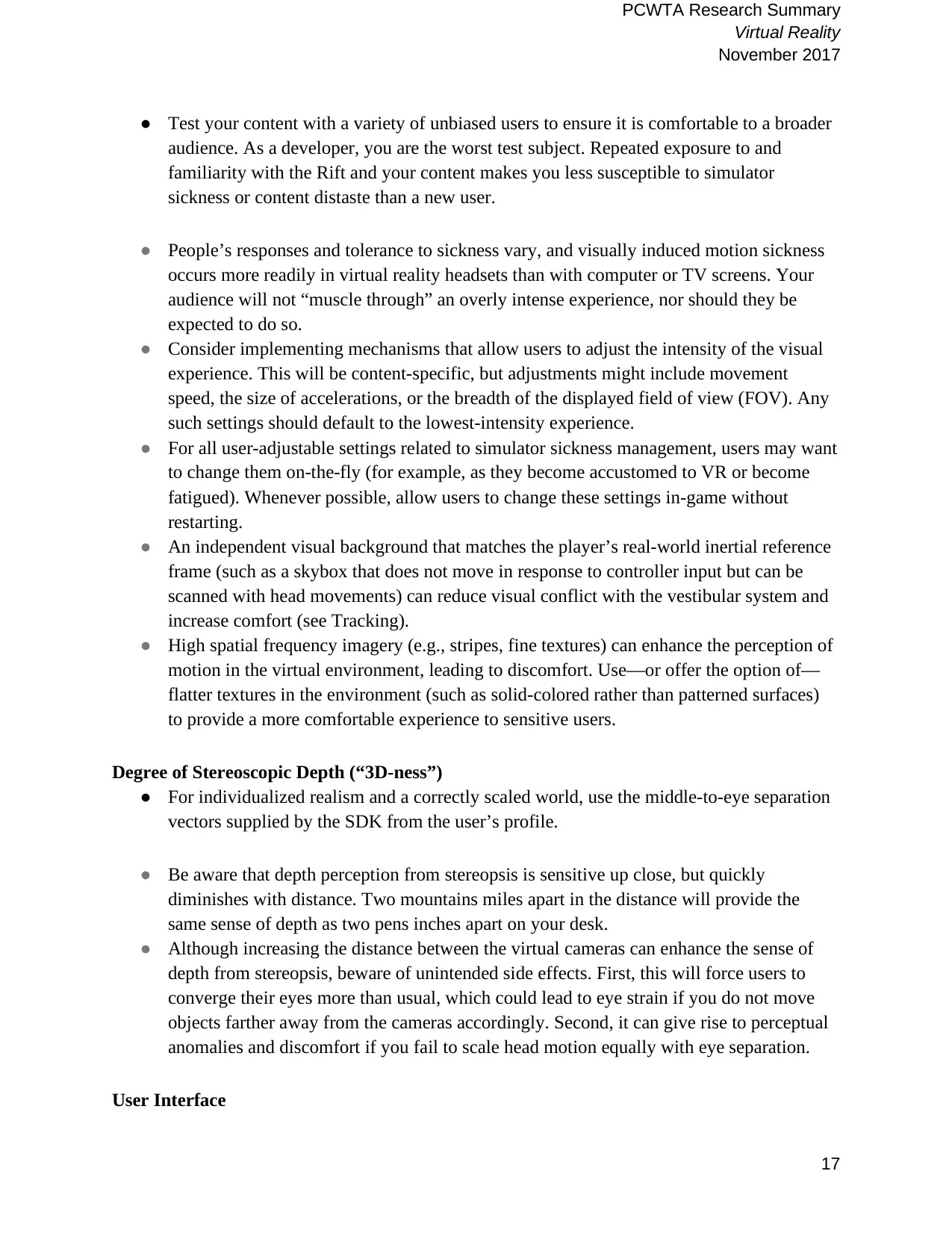
PCWTA Research Summary
Virtual Reality
November 2017
17
● Test your content with a variety of unbiased users to ensure it is comfortable to a broader
audience. As a developer, you are the worst test subject. Repeated exposure to and
familiarity with the Rift and your content makes you less susceptible to simulator
sickness or content distaste than a new user.
● People’s responses and tolerance to sickness vary, and visually induced motion sickness
occurs more readily in virtual reality headsets than with computer or TV screens. Your
audience will not “muscle through” an overly intense experience, nor should they be
expected to do so.
● Consider implementing mechanisms that allow users to adjust the intensity of the visual
experience. This will be content-specific, but adjustments might include movement
speed, the size of accelerations, or the breadth of the displayed field of view (FOV). Any
such settings should default to the lowest-intensity experience.
● For all user-adjustable settings related to simulator sickness management, users may want
to change them on-the-fly (for example, as they become accustomed to VR or become
fatigued). Whenever possible, allow users to change these settings in-game without
restarting.
● An independent visual background that matches the player’s real-world inertial reference
frame (such as a skybox that does not move in response to controller input but can be
scanned with head movements) can reduce visual conflict with the vestibular system and
increase comfort (see Tracking).
● High spatial frequency imagery (e.g., stripes, fine textures) can enhance the perception of
motion in the virtual environment, leading to discomfort. Use—or offer the option of—
flatter textures in the environment (such as solid-colored rather than patterned surfaces)
to provide a more comfortable experience to sensitive users.
Degree of Stereoscopic Depth (“3D-ness”)
● For individualized realism and a correctly scaled world, use the middle-to-eye separation
vectors supplied by the SDK from the user’s profile.
● Be aware that depth perception from stereopsis is sensitive up close, but quickly
diminishes with distance. Two mountains miles apart in the distance will provide the
same sense of depth as two pens inches apart on your desk.
● Although increasing the distance between the virtual cameras can enhance the sense of
depth from stereopsis, beware of unintended side effects. First, this will force users to
converge their eyes more than usual, which could lead to eye strain if you do not move
objects farther away from the cameras accordingly. Second, it can give rise to perceptual
anomalies and discomfort if you fail to scale head motion equally with eye separation.
User Interface
Virtual Reality
November 2017
17
● Test your content with a variety of unbiased users to ensure it is comfortable to a broader
audience. As a developer, you are the worst test subject. Repeated exposure to and
familiarity with the Rift and your content makes you less susceptible to simulator
sickness or content distaste than a new user.
● People’s responses and tolerance to sickness vary, and visually induced motion sickness
occurs more readily in virtual reality headsets than with computer or TV screens. Your
audience will not “muscle through” an overly intense experience, nor should they be
expected to do so.
● Consider implementing mechanisms that allow users to adjust the intensity of the visual
experience. This will be content-specific, but adjustments might include movement
speed, the size of accelerations, or the breadth of the displayed field of view (FOV). Any
such settings should default to the lowest-intensity experience.
● For all user-adjustable settings related to simulator sickness management, users may want
to change them on-the-fly (for example, as they become accustomed to VR or become
fatigued). Whenever possible, allow users to change these settings in-game without
restarting.
● An independent visual background that matches the player’s real-world inertial reference
frame (such as a skybox that does not move in response to controller input but can be
scanned with head movements) can reduce visual conflict with the vestibular system and
increase comfort (see Tracking).
● High spatial frequency imagery (e.g., stripes, fine textures) can enhance the perception of
motion in the virtual environment, leading to discomfort. Use—or offer the option of—
flatter textures in the environment (such as solid-colored rather than patterned surfaces)
to provide a more comfortable experience to sensitive users.
Degree of Stereoscopic Depth (“3D-ness”)
● For individualized realism and a correctly scaled world, use the middle-to-eye separation
vectors supplied by the SDK from the user’s profile.
● Be aware that depth perception from stereopsis is sensitive up close, but quickly
diminishes with distance. Two mountains miles apart in the distance will provide the
same sense of depth as two pens inches apart on your desk.
● Although increasing the distance between the virtual cameras can enhance the sense of
depth from stereopsis, beware of unintended side effects. First, this will force users to
converge their eyes more than usual, which could lead to eye strain if you do not move
objects farther away from the cameras accordingly. Second, it can give rise to perceptual
anomalies and discomfort if you fail to scale head motion equally with eye separation.
User Interface
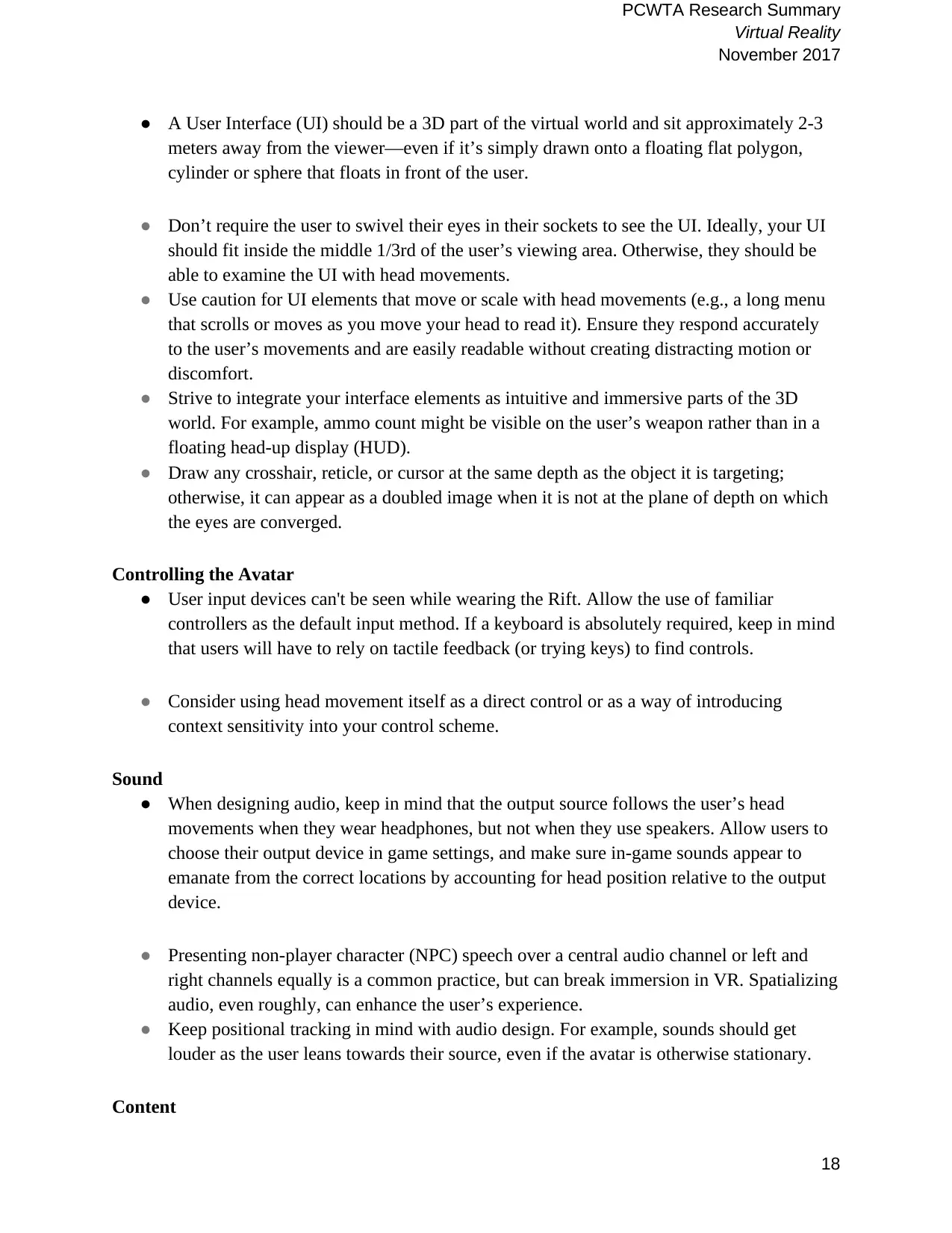
PCWTA Research Summary
Virtual Reality
November 2017
18
● A User Interface (UI) should be a 3D part of the virtual world and sit approximately 2-3
meters away from the viewer—even if it’s simply drawn onto a floating flat polygon,
cylinder or sphere that floats in front of the user.
● Don’t require the user to swivel their eyes in their sockets to see the UI. Ideally, your UI
should fit inside the middle 1/3rd of the user’s viewing area. Otherwise, they should be
able to examine the UI with head movements.
● Use caution for UI elements that move or scale with head movements (e.g., a long menu
that scrolls or moves as you move your head to read it). Ensure they respond accurately
to the user’s movements and are easily readable without creating distracting motion or
discomfort.
● Strive to integrate your interface elements as intuitive and immersive parts of the 3D
world. For example, ammo count might be visible on the user’s weapon rather than in a
floating head-up display (HUD).
● Draw any crosshair, reticle, or cursor at the same depth as the object it is targeting;
otherwise, it can appear as a doubled image when it is not at the plane of depth on which
the eyes are converged.
Controlling the Avatar
● User input devices can't be seen while wearing the Rift. Allow the use of familiar
controllers as the default input method. If a keyboard is absolutely required, keep in mind
that users will have to rely on tactile feedback (or trying keys) to find controls.
● Consider using head movement itself as a direct control or as a way of introducing
context sensitivity into your control scheme.
Sound
● When designing audio, keep in mind that the output source follows the user’s head
movements when they wear headphones, but not when they use speakers. Allow users to
choose their output device in game settings, and make sure in-game sounds appear to
emanate from the correct locations by accounting for head position relative to the output
device.
● Presenting non-player character (NPC) speech over a central audio channel or left and
right channels equally is a common practice, but can break immersion in VR. Spatializing
audio, even roughly, can enhance the user’s experience.
● Keep positional tracking in mind with audio design. For example, sounds should get
louder as the user leans towards their source, even if the avatar is otherwise stationary.
Content
Virtual Reality
November 2017
18
● A User Interface (UI) should be a 3D part of the virtual world and sit approximately 2-3
meters away from the viewer—even if it’s simply drawn onto a floating flat polygon,
cylinder or sphere that floats in front of the user.
● Don’t require the user to swivel their eyes in their sockets to see the UI. Ideally, your UI
should fit inside the middle 1/3rd of the user’s viewing area. Otherwise, they should be
able to examine the UI with head movements.
● Use caution for UI elements that move or scale with head movements (e.g., a long menu
that scrolls or moves as you move your head to read it). Ensure they respond accurately
to the user’s movements and are easily readable without creating distracting motion or
discomfort.
● Strive to integrate your interface elements as intuitive and immersive parts of the 3D
world. For example, ammo count might be visible on the user’s weapon rather than in a
floating head-up display (HUD).
● Draw any crosshair, reticle, or cursor at the same depth as the object it is targeting;
otherwise, it can appear as a doubled image when it is not at the plane of depth on which
the eyes are converged.
Controlling the Avatar
● User input devices can't be seen while wearing the Rift. Allow the use of familiar
controllers as the default input method. If a keyboard is absolutely required, keep in mind
that users will have to rely on tactile feedback (or trying keys) to find controls.
● Consider using head movement itself as a direct control or as a way of introducing
context sensitivity into your control scheme.
Sound
● When designing audio, keep in mind that the output source follows the user’s head
movements when they wear headphones, but not when they use speakers. Allow users to
choose their output device in game settings, and make sure in-game sounds appear to
emanate from the correct locations by accounting for head position relative to the output
device.
● Presenting non-player character (NPC) speech over a central audio channel or left and
right channels equally is a common practice, but can break immersion in VR. Spatializing
audio, even roughly, can enhance the user’s experience.
● Keep positional tracking in mind with audio design. For example, sounds should get
louder as the user leans towards their source, even if the avatar is otherwise stationary.
Content
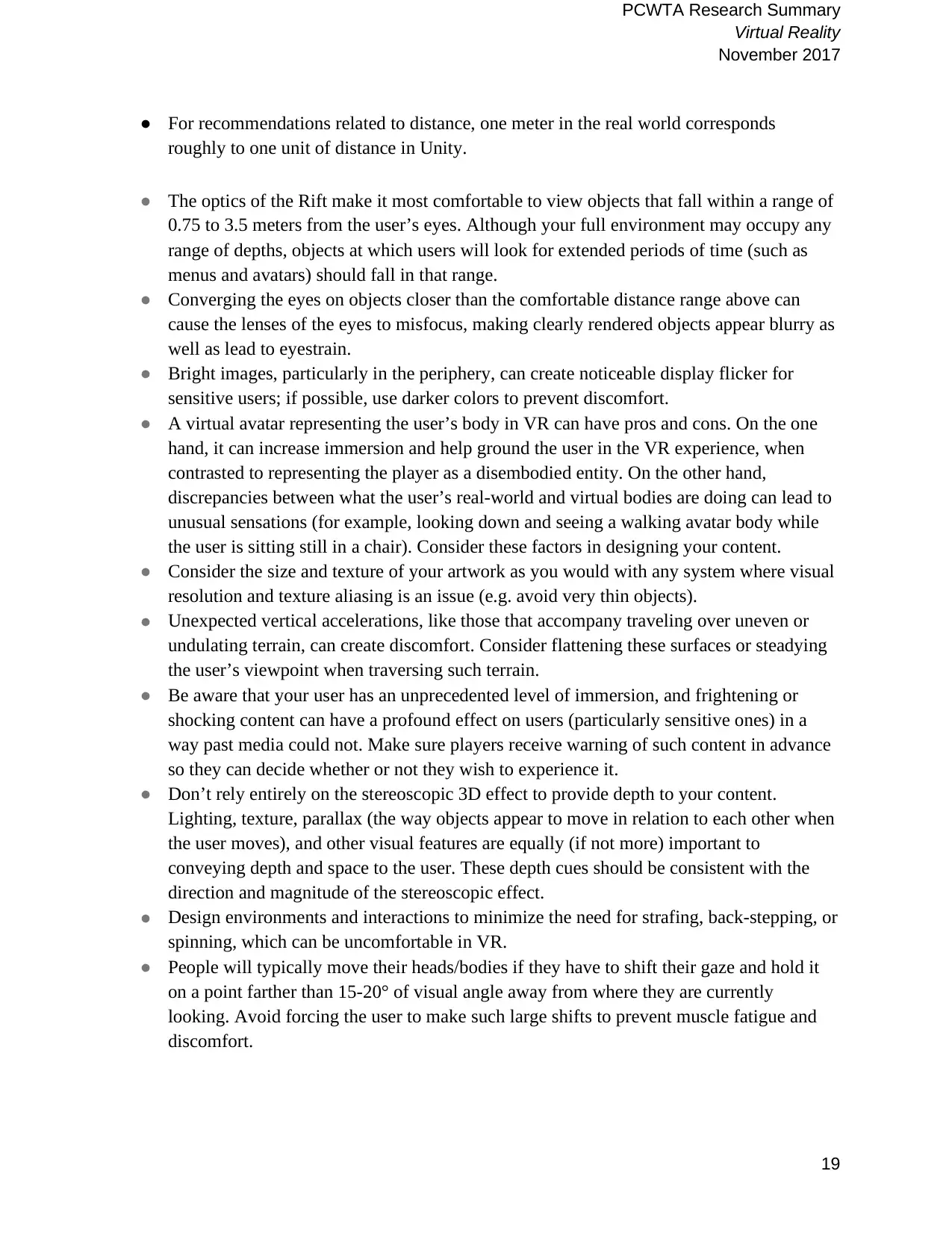
PCWTA Research Summary
Virtual Reality
November 2017
19
● For recommendations related to distance, one meter in the real world corresponds
roughly to one unit of distance in Unity.
● The optics of the Rift make it most comfortable to view objects that fall within a range of
0.75 to 3.5 meters from the user’s eyes. Although your full environment may occupy any
range of depths, objects at which users will look for extended periods of time (such as
menus and avatars) should fall in that range.
● Converging the eyes on objects closer than the comfortable distance range above can
cause the lenses of the eyes to misfocus, making clearly rendered objects appear blurry as
well as lead to eyestrain.
● Bright images, particularly in the periphery, can create noticeable display flicker for
sensitive users; if possible, use darker colors to prevent discomfort.
● A virtual avatar representing the user’s body in VR can have pros and cons. On the one
hand, it can increase immersion and help ground the user in the VR experience, when
contrasted to representing the player as a disembodied entity. On the other hand,
discrepancies between what the user’s real-world and virtual bodies are doing can lead to
unusual sensations (for example, looking down and seeing a walking avatar body while
the user is sitting still in a chair). Consider these factors in designing your content.
● Consider the size and texture of your artwork as you would with any system where visual
resolution and texture aliasing is an issue (e.g. avoid very thin objects).
● Unexpected vertical accelerations, like those that accompany traveling over uneven or
undulating terrain, can create discomfort. Consider flattening these surfaces or steadying
the user’s viewpoint when traversing such terrain.
● Be aware that your user has an unprecedented level of immersion, and frightening or
shocking content can have a profound effect on users (particularly sensitive ones) in a
way past media could not. Make sure players receive warning of such content in advance
so they can decide whether or not they wish to experience it.
● Don’t rely entirely on the stereoscopic 3D effect to provide depth to your content.
Lighting, texture, parallax (the way objects appear to move in relation to each other when
the user moves), and other visual features are equally (if not more) important to
conveying depth and space to the user. These depth cues should be consistent with the
direction and magnitude of the stereoscopic effect.
● Design environments and interactions to minimize the need for strafing, back-stepping, or
spinning, which can be uncomfortable in VR.
● People will typically move their heads/bodies if they have to shift their gaze and hold it
on a point farther than 15-20° of visual angle away from where they are currently
looking. Avoid forcing the user to make such large shifts to prevent muscle fatigue and
discomfort.
Virtual Reality
November 2017
19
● For recommendations related to distance, one meter in the real world corresponds
roughly to one unit of distance in Unity.
● The optics of the Rift make it most comfortable to view objects that fall within a range of
0.75 to 3.5 meters from the user’s eyes. Although your full environment may occupy any
range of depths, objects at which users will look for extended periods of time (such as
menus and avatars) should fall in that range.
● Converging the eyes on objects closer than the comfortable distance range above can
cause the lenses of the eyes to misfocus, making clearly rendered objects appear blurry as
well as lead to eyestrain.
● Bright images, particularly in the periphery, can create noticeable display flicker for
sensitive users; if possible, use darker colors to prevent discomfort.
● A virtual avatar representing the user’s body in VR can have pros and cons. On the one
hand, it can increase immersion and help ground the user in the VR experience, when
contrasted to representing the player as a disembodied entity. On the other hand,
discrepancies between what the user’s real-world and virtual bodies are doing can lead to
unusual sensations (for example, looking down and seeing a walking avatar body while
the user is sitting still in a chair). Consider these factors in designing your content.
● Consider the size and texture of your artwork as you would with any system where visual
resolution and texture aliasing is an issue (e.g. avoid very thin objects).
● Unexpected vertical accelerations, like those that accompany traveling over uneven or
undulating terrain, can create discomfort. Consider flattening these surfaces or steadying
the user’s viewpoint when traversing such terrain.
● Be aware that your user has an unprecedented level of immersion, and frightening or
shocking content can have a profound effect on users (particularly sensitive ones) in a
way past media could not. Make sure players receive warning of such content in advance
so they can decide whether or not they wish to experience it.
● Don’t rely entirely on the stereoscopic 3D effect to provide depth to your content.
Lighting, texture, parallax (the way objects appear to move in relation to each other when
the user moves), and other visual features are equally (if not more) important to
conveying depth and space to the user. These depth cues should be consistent with the
direction and magnitude of the stereoscopic effect.
● Design environments and interactions to minimize the need for strafing, back-stepping, or
spinning, which can be uncomfortable in VR.
● People will typically move their heads/bodies if they have to shift their gaze and hold it
on a point farther than 15-20° of visual angle away from where they are currently
looking. Avoid forcing the user to make such large shifts to prevent muscle fatigue and
discomfort.
Paraphrase This Document
Need a fresh take? Get an instant paraphrase of this document with our AI Paraphraser
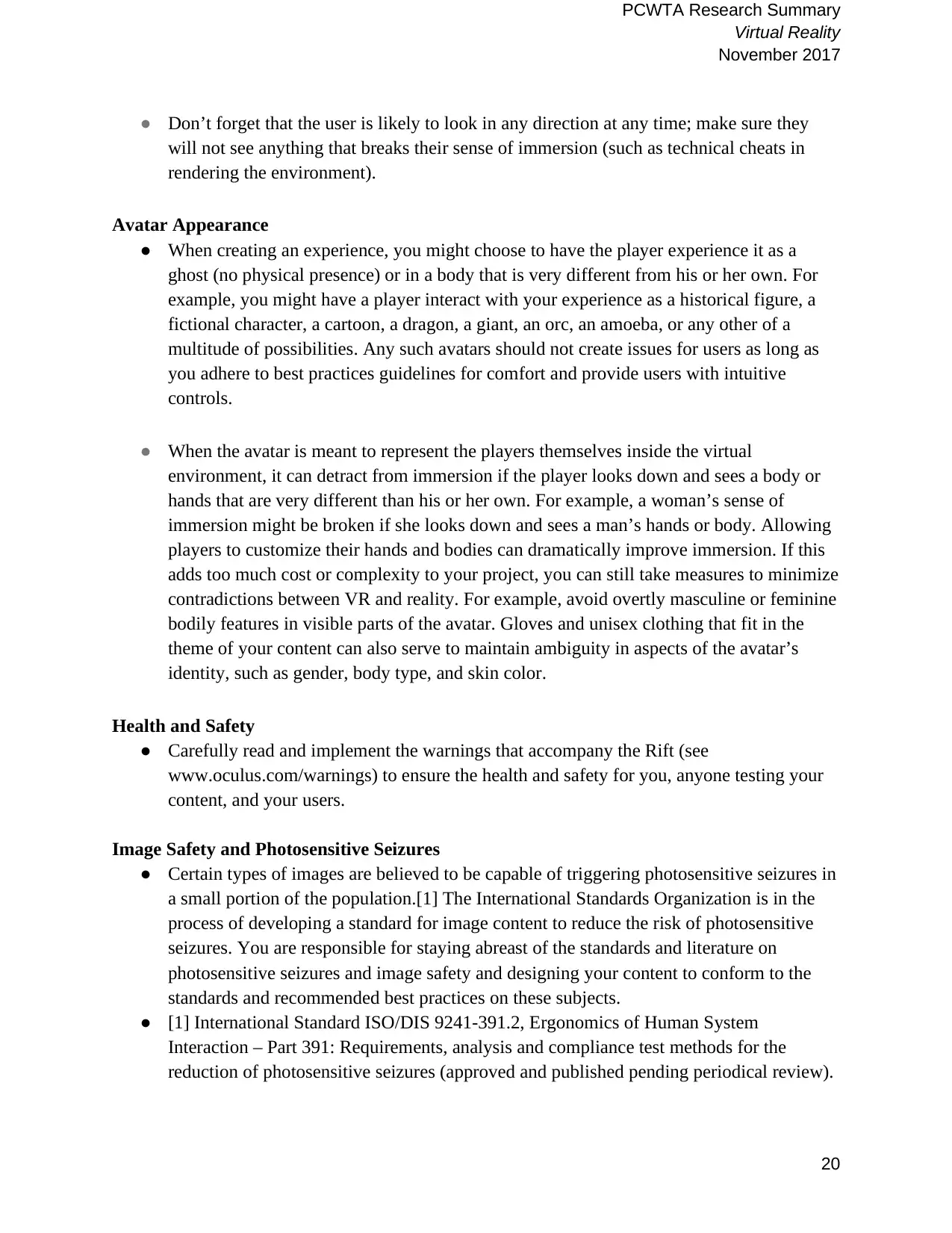
PCWTA Research Summary
Virtual Reality
November 2017
20
● Don’t forget that the user is likely to look in any direction at any time; make sure they
will not see anything that breaks their sense of immersion (such as technical cheats in
rendering the environment).
Avatar Appearance
● When creating an experience, you might choose to have the player experience it as a
ghost (no physical presence) or in a body that is very different from his or her own. For
example, you might have a player interact with your experience as a historical figure, a
fictional character, a cartoon, a dragon, a giant, an orc, an amoeba, or any other of a
multitude of possibilities. Any such avatars should not create issues for users as long as
you adhere to best practices guidelines for comfort and provide users with intuitive
controls.
● When the avatar is meant to represent the players themselves inside the virtual
environment, it can detract from immersion if the player looks down and sees a body or
hands that are very different than his or her own. For example, a woman’s sense of
immersion might be broken if she looks down and sees a man’s hands or body. Allowing
players to customize their hands and bodies can dramatically improve immersion. If this
adds too much cost or complexity to your project, you can still take measures to minimize
contradictions between VR and reality. For example, avoid overtly masculine or feminine
bodily features in visible parts of the avatar. Gloves and unisex clothing that fit in the
theme of your content can also serve to maintain ambiguity in aspects of the avatar’s
identity, such as gender, body type, and skin color.
Health and Safety
● Carefully read and implement the warnings that accompany the Rift (see
www.oculus.com/warnings) to ensure the health and safety for you, anyone testing your
content, and your users.
Image Safety and Photosensitive Seizures
● Certain types of images are believed to be capable of triggering photosensitive seizures in
a small portion of the population.[1] The International Standards Organization is in the
process of developing a standard for image content to reduce the risk of photosensitive
seizures. You are responsible for staying abreast of the standards and literature on
photosensitive seizures and image safety and designing your content to conform to the
standards and recommended best practices on these subjects.
● [1] International Standard ISO/DIS 9241-391.2, Ergonomics of Human System
Interaction – Part 391: Requirements, analysis and compliance test methods for the
reduction of photosensitive seizures (approved and published pending periodical review).
Virtual Reality
November 2017
20
● Don’t forget that the user is likely to look in any direction at any time; make sure they
will not see anything that breaks their sense of immersion (such as technical cheats in
rendering the environment).
Avatar Appearance
● When creating an experience, you might choose to have the player experience it as a
ghost (no physical presence) or in a body that is very different from his or her own. For
example, you might have a player interact with your experience as a historical figure, a
fictional character, a cartoon, a dragon, a giant, an orc, an amoeba, or any other of a
multitude of possibilities. Any such avatars should not create issues for users as long as
you adhere to best practices guidelines for comfort and provide users with intuitive
controls.
● When the avatar is meant to represent the players themselves inside the virtual
environment, it can detract from immersion if the player looks down and sees a body or
hands that are very different than his or her own. For example, a woman’s sense of
immersion might be broken if she looks down and sees a man’s hands or body. Allowing
players to customize their hands and bodies can dramatically improve immersion. If this
adds too much cost or complexity to your project, you can still take measures to minimize
contradictions between VR and reality. For example, avoid overtly masculine or feminine
bodily features in visible parts of the avatar. Gloves and unisex clothing that fit in the
theme of your content can also serve to maintain ambiguity in aspects of the avatar’s
identity, such as gender, body type, and skin color.
Health and Safety
● Carefully read and implement the warnings that accompany the Rift (see
www.oculus.com/warnings) to ensure the health and safety for you, anyone testing your
content, and your users.
Image Safety and Photosensitive Seizures
● Certain types of images are believed to be capable of triggering photosensitive seizures in
a small portion of the population.[1] The International Standards Organization is in the
process of developing a standard for image content to reduce the risk of photosensitive
seizures. You are responsible for staying abreast of the standards and literature on
photosensitive seizures and image safety and designing your content to conform to the
standards and recommended best practices on these subjects.
● [1] International Standard ISO/DIS 9241-391.2, Ergonomics of Human System
Interaction – Part 391: Requirements, analysis and compliance test methods for the
reduction of photosensitive seizures (approved and published pending periodical review).

PCWTA Research Summary
Virtual Reality
November 2017
21
Virtual Reality
November 2017
21
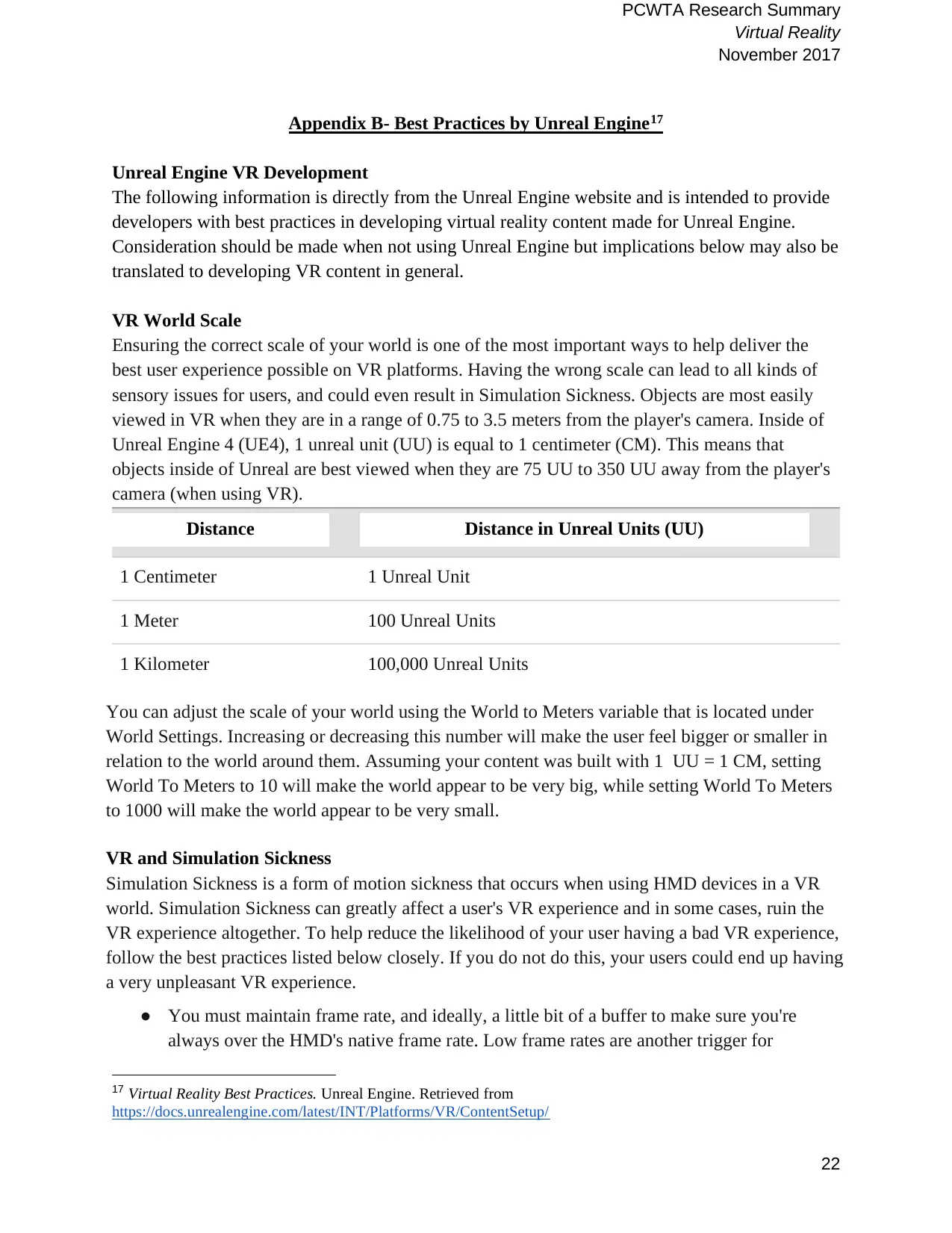
PCWTA Research Summary
Virtual Reality
November 2017
22
Appendix B- Best Practices by Unreal Engine17
Unreal Engine VR Development
The following information is directly from the Unreal Engine website and is intended to provide
developers with best practices in developing virtual reality content made for Unreal Engine.
Consideration should be made when not using Unreal Engine but implications below may also be
translated to developing VR content in general.
VR World Scale
Ensuring the correct scale of your world is one of the most important ways to help deliver the
best user experience possible on VR platforms. Having the wrong scale can lead to all kinds of
sensory issues for users, and could even result in Simulation Sickness. Objects are most easily
viewed in VR when they are in a range of 0.75 to 3.5 meters from the player's camera. Inside of
Unreal Engine 4 (UE4), 1 unreal unit (UU) is equal to 1 centimeter (CM). This means that
objects inside of Unreal are best viewed when they are 75 UU to 350 UU away from the player's
camera (when using VR).
Distance Distance in Unreal Units (UU)
1 Centimeter 1 Unreal Unit
1 Meter 100 Unreal Units
1 Kilometer 100,000 Unreal Units
You can adjust the scale of your world using the World to Meters variable that is located under
World Settings. Increasing or decreasing this number will make the user feel bigger or smaller in
relation to the world around them. Assuming your content was built with 1 UU = 1 CM, setting
World To Meters to 10 will make the world appear to be very big, while setting World To Meters
to 1000 will make the world appear to be very small.
VR and Simulation Sickness
Simulation Sickness is a form of motion sickness that occurs when using HMD devices in a VR
world. Simulation Sickness can greatly affect a user's VR experience and in some cases, ruin the
VR experience altogether. To help reduce the likelihood of your user having a bad VR experience,
follow the best practices listed below closely. If you do not do this, your users could end up having
a very unpleasant VR experience.
● You must maintain frame rate, and ideally, a little bit of a buffer to make sure you're
always over the HMD's native frame rate. Low frame rates are another trigger for
17 Virtual Reality Best Practices. Unreal Engine. Retrieved from
https://docs.unrealengine.com/latest/INT/Platforms/VR/ContentSetup/
Virtual Reality
November 2017
22
Appendix B- Best Practices by Unreal Engine17
Unreal Engine VR Development
The following information is directly from the Unreal Engine website and is intended to provide
developers with best practices in developing virtual reality content made for Unreal Engine.
Consideration should be made when not using Unreal Engine but implications below may also be
translated to developing VR content in general.
VR World Scale
Ensuring the correct scale of your world is one of the most important ways to help deliver the
best user experience possible on VR platforms. Having the wrong scale can lead to all kinds of
sensory issues for users, and could even result in Simulation Sickness. Objects are most easily
viewed in VR when they are in a range of 0.75 to 3.5 meters from the player's camera. Inside of
Unreal Engine 4 (UE4), 1 unreal unit (UU) is equal to 1 centimeter (CM). This means that
objects inside of Unreal are best viewed when they are 75 UU to 350 UU away from the player's
camera (when using VR).
Distance Distance in Unreal Units (UU)
1 Centimeter 1 Unreal Unit
1 Meter 100 Unreal Units
1 Kilometer 100,000 Unreal Units
You can adjust the scale of your world using the World to Meters variable that is located under
World Settings. Increasing or decreasing this number will make the user feel bigger or smaller in
relation to the world around them. Assuming your content was built with 1 UU = 1 CM, setting
World To Meters to 10 will make the world appear to be very big, while setting World To Meters
to 1000 will make the world appear to be very small.
VR and Simulation Sickness
Simulation Sickness is a form of motion sickness that occurs when using HMD devices in a VR
world. Simulation Sickness can greatly affect a user's VR experience and in some cases, ruin the
VR experience altogether. To help reduce the likelihood of your user having a bad VR experience,
follow the best practices listed below closely. If you do not do this, your users could end up having
a very unpleasant VR experience.
● You must maintain frame rate, and ideally, a little bit of a buffer to make sure you're
always over the HMD's native frame rate. Low frame rates are another trigger for
17 Virtual Reality Best Practices. Unreal Engine. Retrieved from
https://docs.unrealengine.com/latest/INT/Platforms/VR/ContentSetup/
Secure Best Marks with AI Grader
Need help grading? Try our AI Grader for instant feedback on your assignments.
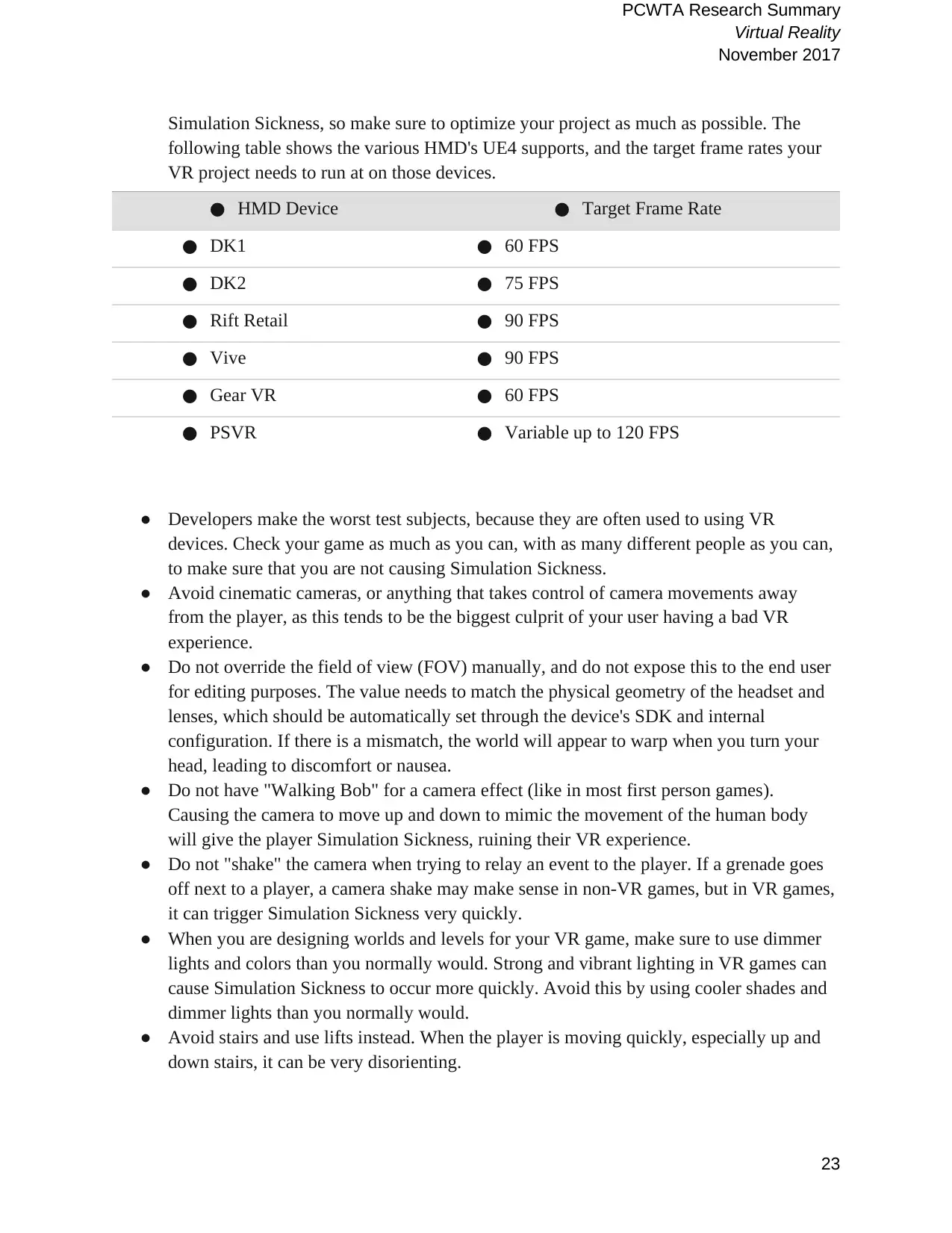
PCWTA Research Summary
Virtual Reality
November 2017
23
Simulation Sickness, so make sure to optimize your project as much as possible. The
following table shows the various HMD's UE4 supports, and the target frame rates your
VR project needs to run at on those devices.
● HMD Device ● Target Frame Rate
● DK1 ● 60 FPS
● DK2 ● 75 FPS
● Rift Retail ● 90 FPS
● Vive ● 90 FPS
● Gear VR ● 60 FPS
● PSVR ● Variable up to 120 FPS
● Developers make the worst test subjects, because they are often used to using VR
devices. Check your game as much as you can, with as many different people as you can,
to make sure that you are not causing Simulation Sickness.
● Avoid cinematic cameras, or anything that takes control of camera movements away
from the player, as this tends to be the biggest culprit of your user having a bad VR
experience.
● Do not override the field of view (FOV) manually, and do not expose this to the end user
for editing purposes. The value needs to match the physical geometry of the headset and
lenses, which should be automatically set through the device's SDK and internal
configuration. If there is a mismatch, the world will appear to warp when you turn your
head, leading to discomfort or nausea.
● Do not have "Walking Bob" for a camera effect (like in most first person games).
Causing the camera to move up and down to mimic the movement of the human body
will give the player Simulation Sickness, ruining their VR experience.
● Do not "shake" the camera when trying to relay an event to the player. If a grenade goes
off next to a player, a camera shake may make sense in non-VR games, but in VR games,
it can trigger Simulation Sickness very quickly.
● When you are designing worlds and levels for your VR game, make sure to use dimmer
lights and colors than you normally would. Strong and vibrant lighting in VR games can
cause Simulation Sickness to occur more quickly. Avoid this by using cooler shades and
dimmer lights than you normally would.
● Avoid stairs and use lifts instead. When the player is moving quickly, especially up and
down stairs, it can be very disorienting.
Virtual Reality
November 2017
23
Simulation Sickness, so make sure to optimize your project as much as possible. The
following table shows the various HMD's UE4 supports, and the target frame rates your
VR project needs to run at on those devices.
● HMD Device ● Target Frame Rate
● DK1 ● 60 FPS
● DK2 ● 75 FPS
● Rift Retail ● 90 FPS
● Vive ● 90 FPS
● Gear VR ● 60 FPS
● PSVR ● Variable up to 120 FPS
● Developers make the worst test subjects, because they are often used to using VR
devices. Check your game as much as you can, with as many different people as you can,
to make sure that you are not causing Simulation Sickness.
● Avoid cinematic cameras, or anything that takes control of camera movements away
from the player, as this tends to be the biggest culprit of your user having a bad VR
experience.
● Do not override the field of view (FOV) manually, and do not expose this to the end user
for editing purposes. The value needs to match the physical geometry of the headset and
lenses, which should be automatically set through the device's SDK and internal
configuration. If there is a mismatch, the world will appear to warp when you turn your
head, leading to discomfort or nausea.
● Do not have "Walking Bob" for a camera effect (like in most first person games).
Causing the camera to move up and down to mimic the movement of the human body
will give the player Simulation Sickness, ruining their VR experience.
● Do not "shake" the camera when trying to relay an event to the player. If a grenade goes
off next to a player, a camera shake may make sense in non-VR games, but in VR games,
it can trigger Simulation Sickness very quickly.
● When you are designing worlds and levels for your VR game, make sure to use dimmer
lights and colors than you normally would. Strong and vibrant lighting in VR games can
cause Simulation Sickness to occur more quickly. Avoid this by using cooler shades and
dimmer lights than you normally would.
● Avoid stairs and use lifts instead. When the player is moving quickly, especially up and
down stairs, it can be very disorienting.
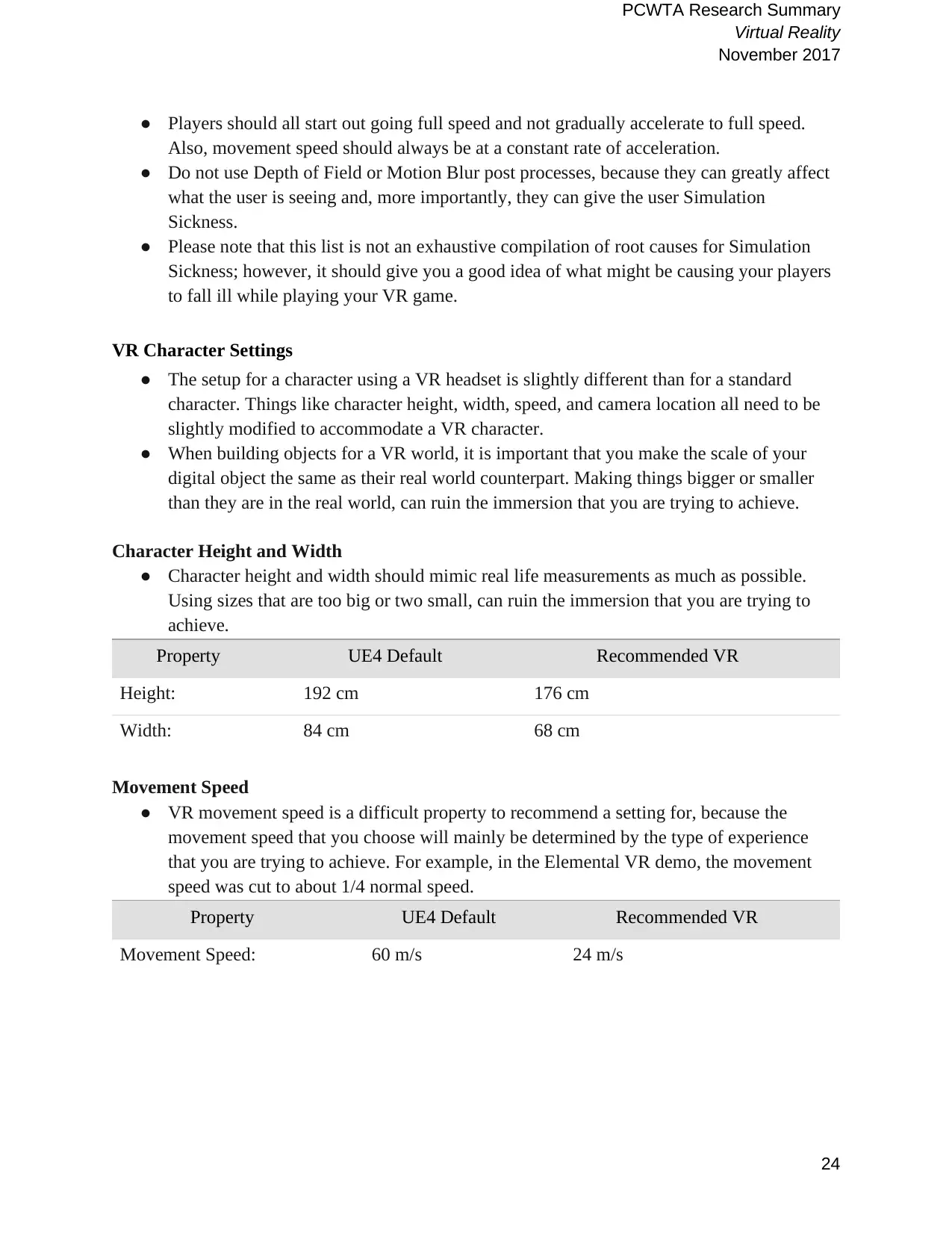
PCWTA Research Summary
Virtual Reality
November 2017
24
● Players should all start out going full speed and not gradually accelerate to full speed.
Also, movement speed should always be at a constant rate of acceleration.
● Do not use Depth of Field or Motion Blur post processes, because they can greatly affect
what the user is seeing and, more importantly, they can give the user Simulation
Sickness.
● Please note that this list is not an exhaustive compilation of root causes for Simulation
Sickness; however, it should give you a good idea of what might be causing your players
to fall ill while playing your VR game.
VR Character Settings
● The setup for a character using a VR headset is slightly different than for a standard
character. Things like character height, width, speed, and camera location all need to be
slightly modified to accommodate a VR character.
● When building objects for a VR world, it is important that you make the scale of your
digital object the same as their real world counterpart. Making things bigger or smaller
than they are in the real world, can ruin the immersion that you are trying to achieve.
Character Height and Width
● Character height and width should mimic real life measurements as much as possible.
Using sizes that are too big or two small, can ruin the immersion that you are trying to
achieve.
Property UE4 Default Recommended VR
Height: 192 cm 176 cm
Width: 84 cm 68 cm
Movement Speed
● VR movement speed is a difficult property to recommend a setting for, because the
movement speed that you choose will mainly be determined by the type of experience
that you are trying to achieve. For example, in the Elemental VR demo, the movement
speed was cut to about 1/4 normal speed.
Property UE4 Default Recommended VR
Movement Speed: 60 m/s 24 m/s
Virtual Reality
November 2017
24
● Players should all start out going full speed and not gradually accelerate to full speed.
Also, movement speed should always be at a constant rate of acceleration.
● Do not use Depth of Field or Motion Blur post processes, because they can greatly affect
what the user is seeing and, more importantly, they can give the user Simulation
Sickness.
● Please note that this list is not an exhaustive compilation of root causes for Simulation
Sickness; however, it should give you a good idea of what might be causing your players
to fall ill while playing your VR game.
VR Character Settings
● The setup for a character using a VR headset is slightly different than for a standard
character. Things like character height, width, speed, and camera location all need to be
slightly modified to accommodate a VR character.
● When building objects for a VR world, it is important that you make the scale of your
digital object the same as their real world counterpart. Making things bigger or smaller
than they are in the real world, can ruin the immersion that you are trying to achieve.
Character Height and Width
● Character height and width should mimic real life measurements as much as possible.
Using sizes that are too big or two small, can ruin the immersion that you are trying to
achieve.
Property UE4 Default Recommended VR
Height: 192 cm 176 cm
Width: 84 cm 68 cm
Movement Speed
● VR movement speed is a difficult property to recommend a setting for, because the
movement speed that you choose will mainly be determined by the type of experience
that you are trying to achieve. For example, in the Elemental VR demo, the movement
speed was cut to about 1/4 normal speed.
Property UE4 Default Recommended VR
Movement Speed: 60 m/s 24 m/s
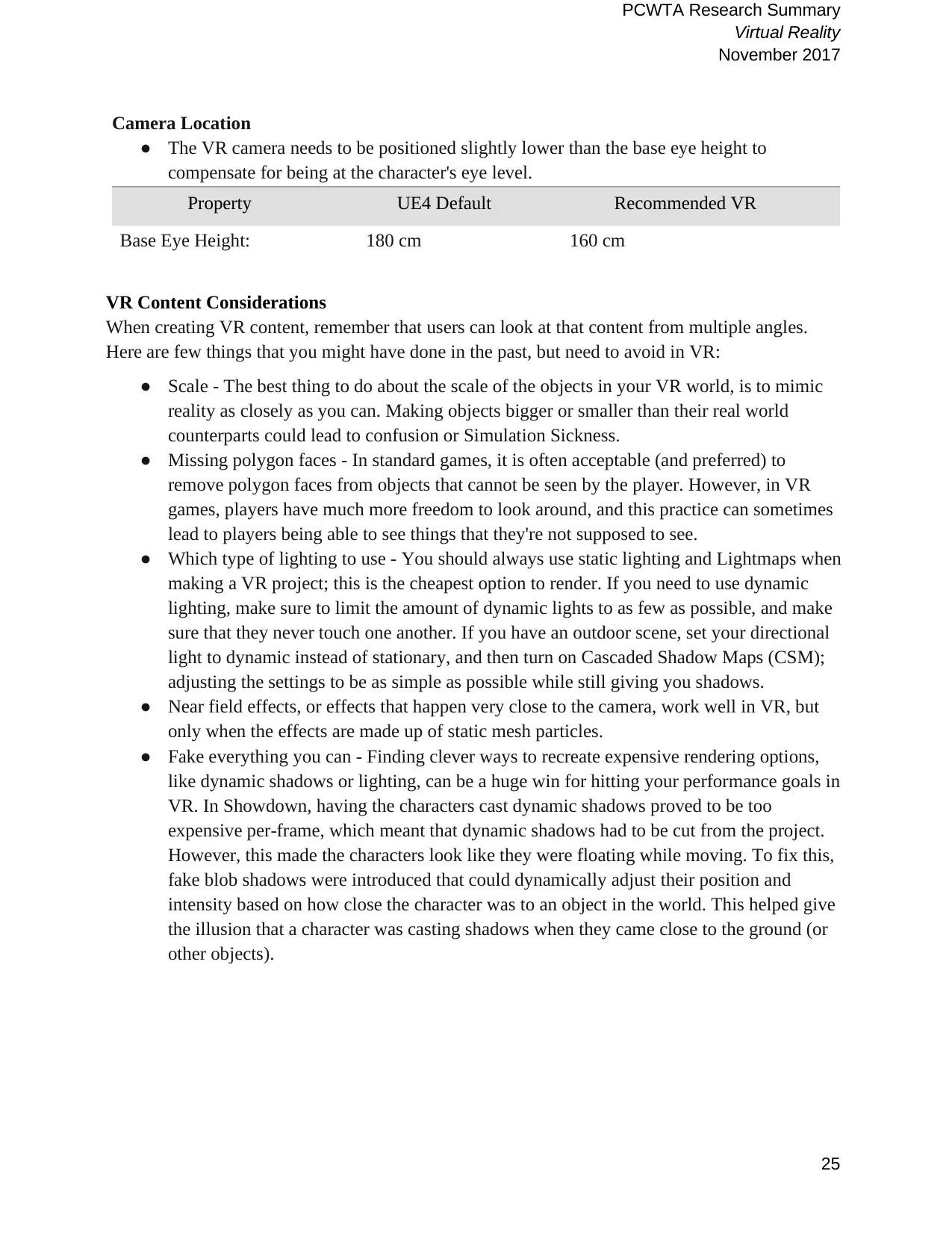
PCWTA Research Summary
Virtual Reality
November 2017
25
Camera Location
● The VR camera needs to be positioned slightly lower than the base eye height to
compensate for being at the character's eye level.
Property UE4 Default Recommended VR
Base Eye Height: 180 cm 160 cm
VR Content Considerations
When creating VR content, remember that users can look at that content from multiple angles.
Here are few things that you might have done in the past, but need to avoid in VR:
● Scale - The best thing to do about the scale of the objects in your VR world, is to mimic
reality as closely as you can. Making objects bigger or smaller than their real world
counterparts could lead to confusion or Simulation Sickness.
● Missing polygon faces - In standard games, it is often acceptable (and preferred) to
remove polygon faces from objects that cannot be seen by the player. However, in VR
games, players have much more freedom to look around, and this practice can sometimes
lead to players being able to see things that they're not supposed to see.
● Which type of lighting to use - You should always use static lighting and Lightmaps when
making a VR project; this is the cheapest option to render. If you need to use dynamic
lighting, make sure to limit the amount of dynamic lights to as few as possible, and make
sure that they never touch one another. If you have an outdoor scene, set your directional
light to dynamic instead of stationary, and then turn on Cascaded Shadow Maps (CSM);
adjusting the settings to be as simple as possible while still giving you shadows.
● Near field effects, or effects that happen very close to the camera, work well in VR, but
only when the effects are made up of static mesh particles.
● Fake everything you can - Finding clever ways to recreate expensive rendering options,
like dynamic shadows or lighting, can be a huge win for hitting your performance goals in
VR. In Showdown, having the characters cast dynamic shadows proved to be too
expensive per-frame, which meant that dynamic shadows had to be cut from the project.
However, this made the characters look like they were floating while moving. To fix this,
fake blob shadows were introduced that could dynamically adjust their position and
intensity based on how close the character was to an object in the world. This helped give
the illusion that a character was casting shadows when they came close to the ground (or
other objects).
Virtual Reality
November 2017
25
Camera Location
● The VR camera needs to be positioned slightly lower than the base eye height to
compensate for being at the character's eye level.
Property UE4 Default Recommended VR
Base Eye Height: 180 cm 160 cm
VR Content Considerations
When creating VR content, remember that users can look at that content from multiple angles.
Here are few things that you might have done in the past, but need to avoid in VR:
● Scale - The best thing to do about the scale of the objects in your VR world, is to mimic
reality as closely as you can. Making objects bigger or smaller than their real world
counterparts could lead to confusion or Simulation Sickness.
● Missing polygon faces - In standard games, it is often acceptable (and preferred) to
remove polygon faces from objects that cannot be seen by the player. However, in VR
games, players have much more freedom to look around, and this practice can sometimes
lead to players being able to see things that they're not supposed to see.
● Which type of lighting to use - You should always use static lighting and Lightmaps when
making a VR project; this is the cheapest option to render. If you need to use dynamic
lighting, make sure to limit the amount of dynamic lights to as few as possible, and make
sure that they never touch one another. If you have an outdoor scene, set your directional
light to dynamic instead of stationary, and then turn on Cascaded Shadow Maps (CSM);
adjusting the settings to be as simple as possible while still giving you shadows.
● Near field effects, or effects that happen very close to the camera, work well in VR, but
only when the effects are made up of static mesh particles.
● Fake everything you can - Finding clever ways to recreate expensive rendering options,
like dynamic shadows or lighting, can be a huge win for hitting your performance goals in
VR. In Showdown, having the characters cast dynamic shadows proved to be too
expensive per-frame, which meant that dynamic shadows had to be cut from the project.
However, this made the characters look like they were floating while moving. To fix this,
fake blob shadows were introduced that could dynamically adjust their position and
intensity based on how close the character was to an object in the world. This helped give
the illusion that a character was casting shadows when they came close to the ground (or
other objects).
Paraphrase This Document
Need a fresh take? Get an instant paraphrase of this document with our AI Paraphraser
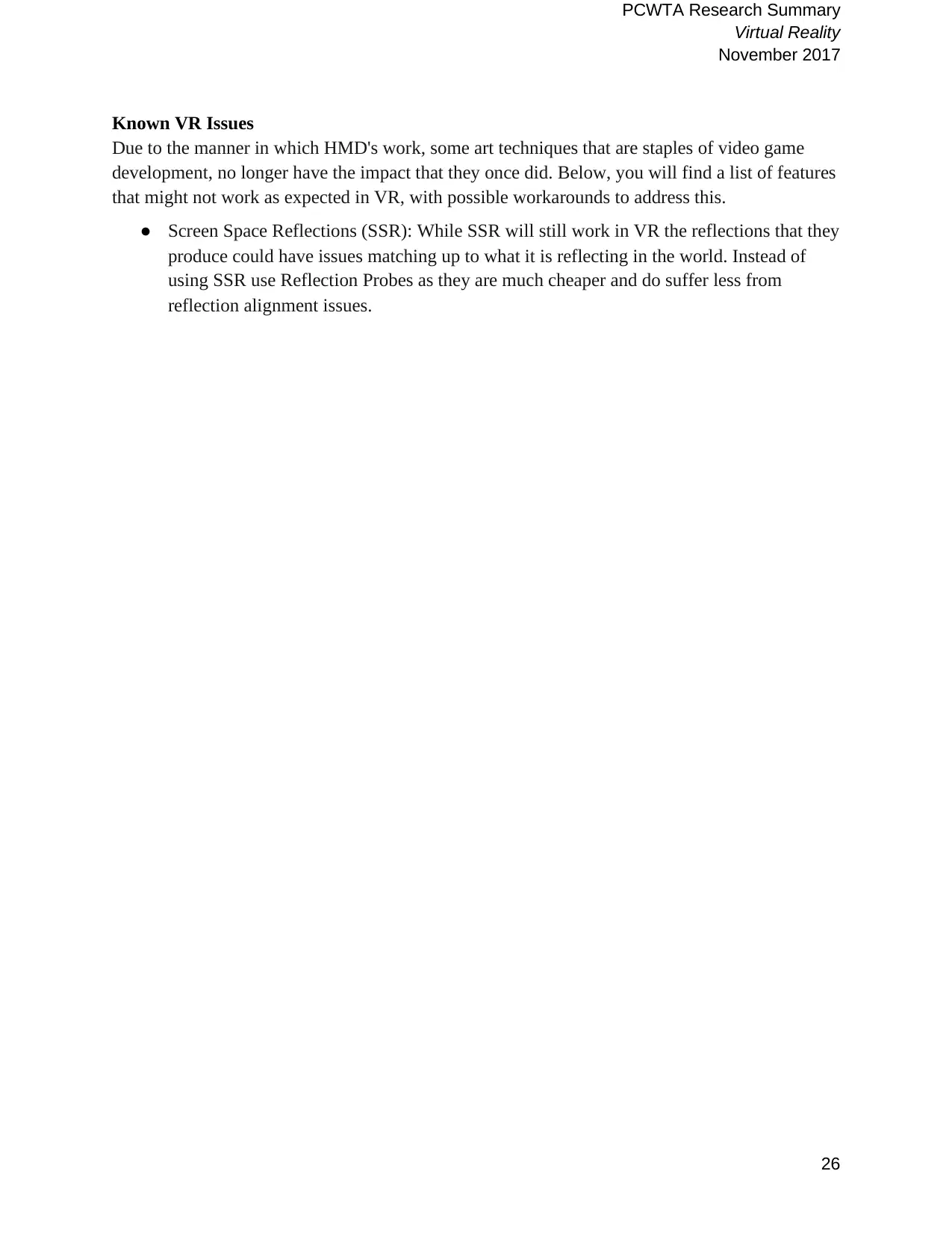
PCWTA Research Summary
Virtual Reality
November 2017
26
Known VR Issues
Due to the manner in which HMD's work, some art techniques that are staples of video game
development, no longer have the impact that they once did. Below, you will find a list of features
that might not work as expected in VR, with possible workarounds to address this.
● Screen Space Reflections (SSR): While SSR will still work in VR the reflections that they
produce could have issues matching up to what it is reflecting in the world. Instead of
using SSR use Reflection Probes as they are much cheaper and do suffer less from
reflection alignment issues.
Virtual Reality
November 2017
26
Known VR Issues
Due to the manner in which HMD's work, some art techniques that are staples of video game
development, no longer have the impact that they once did. Below, you will find a list of features
that might not work as expected in VR, with possible workarounds to address this.
● Screen Space Reflections (SSR): While SSR will still work in VR the reflections that they
produce could have issues matching up to what it is reflecting in the world. Instead of
using SSR use Reflection Probes as they are much cheaper and do suffer less from
reflection alignment issues.
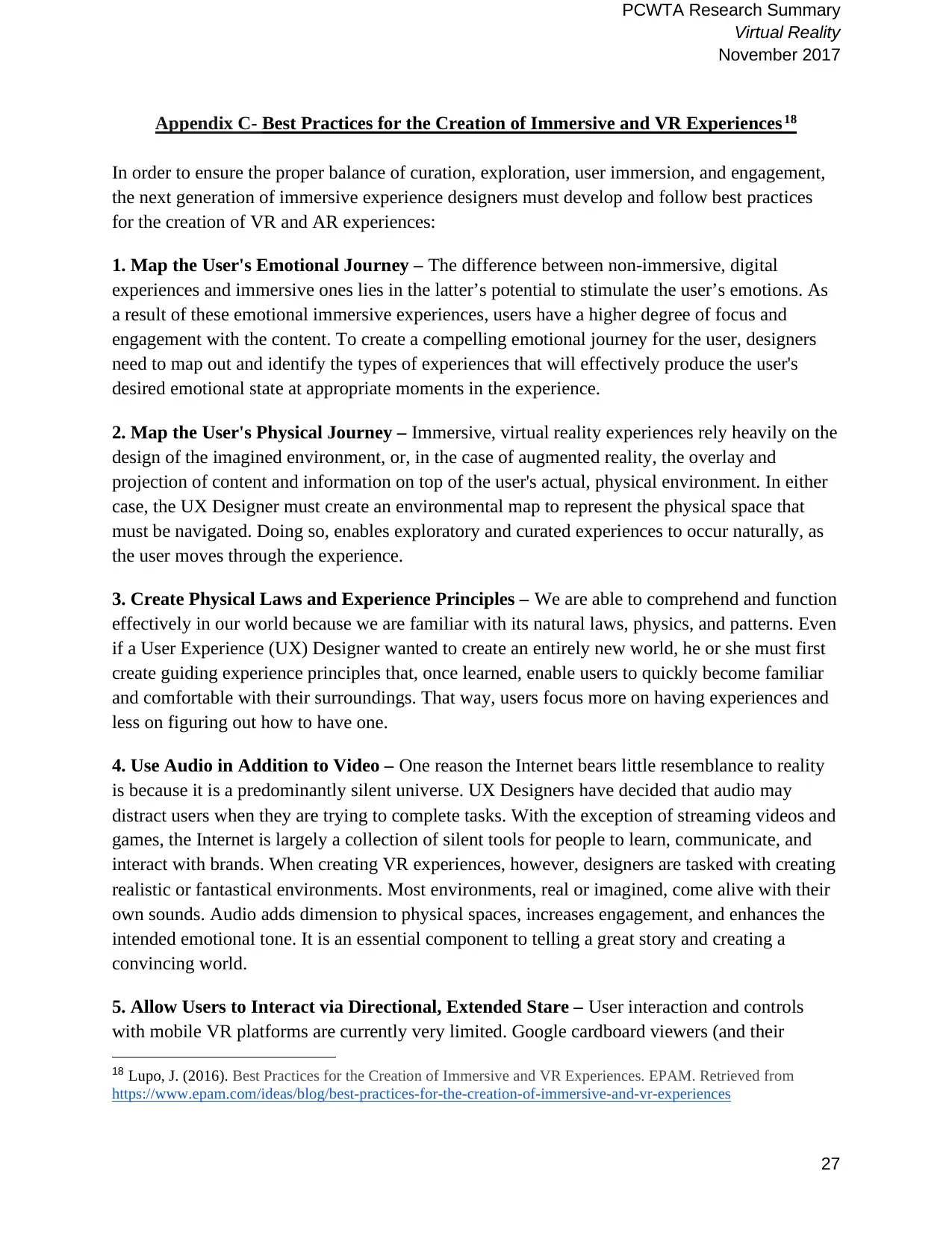
PCWTA Research Summary
Virtual Reality
November 2017
27
Appendix C- Best Practices for the Creation of Immersive and VR Experiences18
In order to ensure the proper balance of curation, exploration, user immersion, and engagement,
the next generation of immersive experience designers must develop and follow best practices
for the creation of VR and AR experiences:
1. Map the User's Emotional Journey – The difference between non-immersive, digital
experiences and immersive ones lies in the latter’s potential to stimulate the user’s emotions. As
a result of these emotional immersive experiences, users have a higher degree of focus and
engagement with the content. To create a compelling emotional journey for the user, designers
need to map out and identify the types of experiences that will effectively produce the user's
desired emotional state at appropriate moments in the experience.
2. Map the User's Physical Journey – Immersive, virtual reality experiences rely heavily on the
design of the imagined environment, or, in the case of augmented reality, the overlay and
projection of content and information on top of the user's actual, physical environment. In either
case, the UX Designer must create an environmental map to represent the physical space that
must be navigated. Doing so, enables exploratory and curated experiences to occur naturally, as
the user moves through the experience.
3. Create Physical Laws and Experience Principles – We are able to comprehend and function
effectively in our world because we are familiar with its natural laws, physics, and patterns. Even
if a User Experience (UX) Designer wanted to create an entirely new world, he or she must first
create guiding experience principles that, once learned, enable users to quickly become familiar
and comfortable with their surroundings. That way, users focus more on having experiences and
less on figuring out how to have one.
4. Use Audio in Addition to Video – One reason the Internet bears little resemblance to reality
is because it is a predominantly silent universe. UX Designers have decided that audio may
distract users when they are trying to complete tasks. With the exception of streaming videos and
games, the Internet is largely a collection of silent tools for people to learn, communicate, and
interact with brands. When creating VR experiences, however, designers are tasked with creating
realistic or fantastical environments. Most environments, real or imagined, come alive with their
own sounds. Audio adds dimension to physical spaces, increases engagement, and enhances the
intended emotional tone. It is an essential component to telling a great story and creating a
convincing world.
5. Allow Users to Interact via Directional, Extended Stare – User interaction and controls
with mobile VR platforms are currently very limited. Google cardboard viewers (and their
18 Lupo, J. (2016). Best Practices for the Creation of Immersive and VR Experiences. EPAM. Retrieved from
https://www.epam.com/ideas/blog/best-practices-for-the-creation-of-immersive-and-vr-experiences
Virtual Reality
November 2017
27
Appendix C- Best Practices for the Creation of Immersive and VR Experiences18
In order to ensure the proper balance of curation, exploration, user immersion, and engagement,
the next generation of immersive experience designers must develop and follow best practices
for the creation of VR and AR experiences:
1. Map the User's Emotional Journey – The difference between non-immersive, digital
experiences and immersive ones lies in the latter’s potential to stimulate the user’s emotions. As
a result of these emotional immersive experiences, users have a higher degree of focus and
engagement with the content. To create a compelling emotional journey for the user, designers
need to map out and identify the types of experiences that will effectively produce the user's
desired emotional state at appropriate moments in the experience.
2. Map the User's Physical Journey – Immersive, virtual reality experiences rely heavily on the
design of the imagined environment, or, in the case of augmented reality, the overlay and
projection of content and information on top of the user's actual, physical environment. In either
case, the UX Designer must create an environmental map to represent the physical space that
must be navigated. Doing so, enables exploratory and curated experiences to occur naturally, as
the user moves through the experience.
3. Create Physical Laws and Experience Principles – We are able to comprehend and function
effectively in our world because we are familiar with its natural laws, physics, and patterns. Even
if a User Experience (UX) Designer wanted to create an entirely new world, he or she must first
create guiding experience principles that, once learned, enable users to quickly become familiar
and comfortable with their surroundings. That way, users focus more on having experiences and
less on figuring out how to have one.
4. Use Audio in Addition to Video – One reason the Internet bears little resemblance to reality
is because it is a predominantly silent universe. UX Designers have decided that audio may
distract users when they are trying to complete tasks. With the exception of streaming videos and
games, the Internet is largely a collection of silent tools for people to learn, communicate, and
interact with brands. When creating VR experiences, however, designers are tasked with creating
realistic or fantastical environments. Most environments, real or imagined, come alive with their
own sounds. Audio adds dimension to physical spaces, increases engagement, and enhances the
intended emotional tone. It is an essential component to telling a great story and creating a
convincing world.
5. Allow Users to Interact via Directional, Extended Stare – User interaction and controls
with mobile VR platforms are currently very limited. Google cardboard viewers (and their
18 Lupo, J. (2016). Best Practices for the Creation of Immersive and VR Experiences. EPAM. Retrieved from
https://www.epam.com/ideas/blog/best-practices-for-the-creation-of-immersive-and-vr-experiences
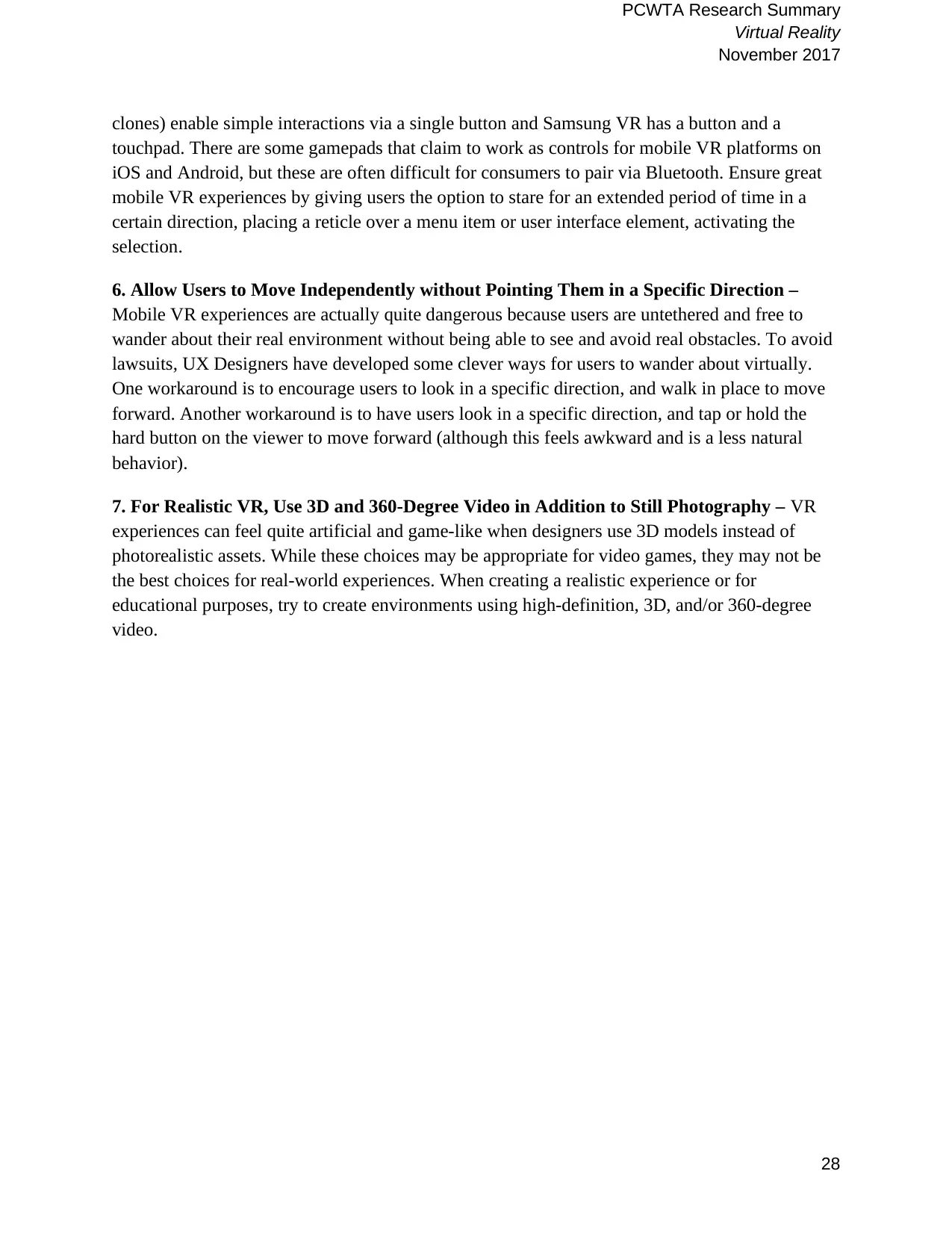
PCWTA Research Summary
Virtual Reality
November 2017
28
clones) enable simple interactions via a single button and Samsung VR has a button and a
touchpad. There are some gamepads that claim to work as controls for mobile VR platforms on
iOS and Android, but these are often difficult for consumers to pair via Bluetooth. Ensure great
mobile VR experiences by giving users the option to stare for an extended period of time in a
certain direction, placing a reticle over a menu item or user interface element, activating the
selection.
6. Allow Users to Move Independently without Pointing Them in a Specific Direction –
Mobile VR experiences are actually quite dangerous because users are untethered and free to
wander about their real environment without being able to see and avoid real obstacles. To avoid
lawsuits, UX Designers have developed some clever ways for users to wander about virtually.
One workaround is to encourage users to look in a specific direction, and walk in place to move
forward. Another workaround is to have users look in a specific direction, and tap or hold the
hard button on the viewer to move forward (although this feels awkward and is a less natural
behavior).
7. For Realistic VR, Use 3D and 360-Degree Video in Addition to Still Photography – VR
experiences can feel quite artificial and game-like when designers use 3D models instead of
photorealistic assets. While these choices may be appropriate for video games, they may not be
the best choices for real-world experiences. When creating a realistic experience or for
educational purposes, try to create environments using high-definition, 3D, and/or 360-degree
video.
Virtual Reality
November 2017
28
clones) enable simple interactions via a single button and Samsung VR has a button and a
touchpad. There are some gamepads that claim to work as controls for mobile VR platforms on
iOS and Android, but these are often difficult for consumers to pair via Bluetooth. Ensure great
mobile VR experiences by giving users the option to stare for an extended period of time in a
certain direction, placing a reticle over a menu item or user interface element, activating the
selection.
6. Allow Users to Move Independently without Pointing Them in a Specific Direction –
Mobile VR experiences are actually quite dangerous because users are untethered and free to
wander about their real environment without being able to see and avoid real obstacles. To avoid
lawsuits, UX Designers have developed some clever ways for users to wander about virtually.
One workaround is to encourage users to look in a specific direction, and walk in place to move
forward. Another workaround is to have users look in a specific direction, and tap or hold the
hard button on the viewer to move forward (although this feels awkward and is a less natural
behavior).
7. For Realistic VR, Use 3D and 360-Degree Video in Addition to Still Photography – VR
experiences can feel quite artificial and game-like when designers use 3D models instead of
photorealistic assets. While these choices may be appropriate for video games, they may not be
the best choices for real-world experiences. When creating a realistic experience or for
educational purposes, try to create environments using high-definition, 3D, and/or 360-degree
video.
1 out of 28
Related Documents
Your All-in-One AI-Powered Toolkit for Academic Success.
+13062052269
info@desklib.com
Available 24*7 on WhatsApp / Email
![[object Object]](/_next/static/media/star-bottom.7253800d.svg)
Unlock your academic potential
© 2024 | Zucol Services PVT LTD | All rights reserved.





